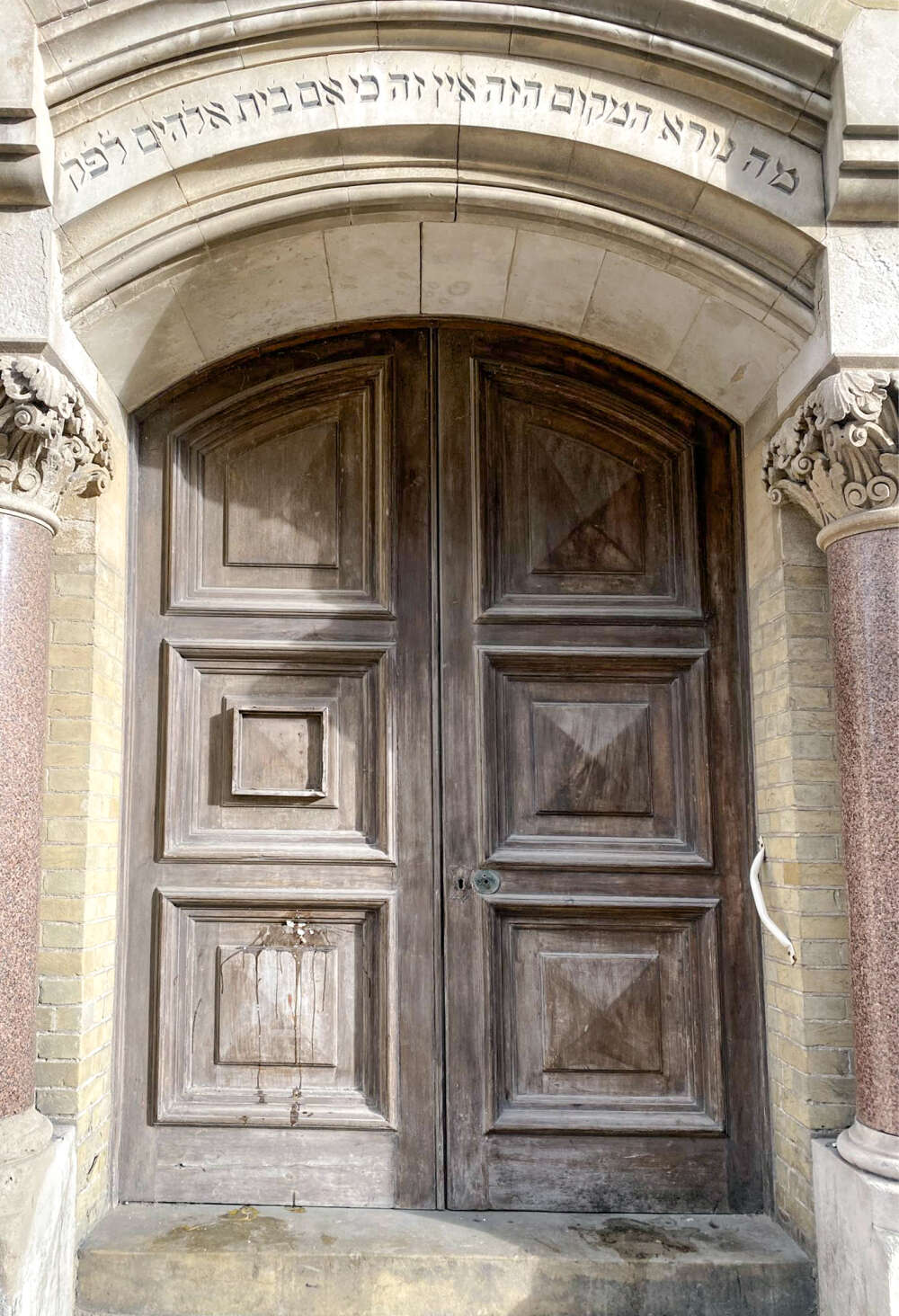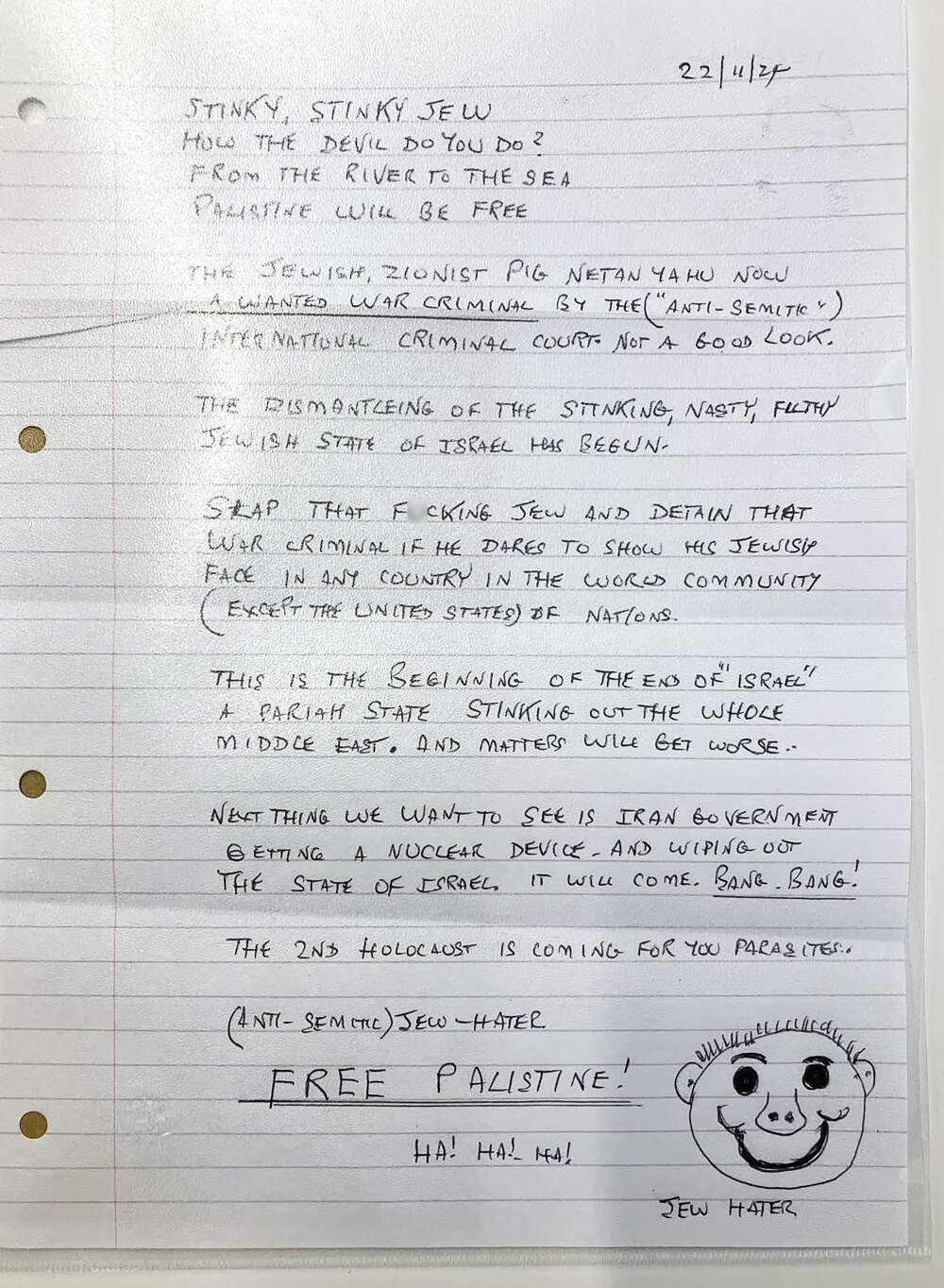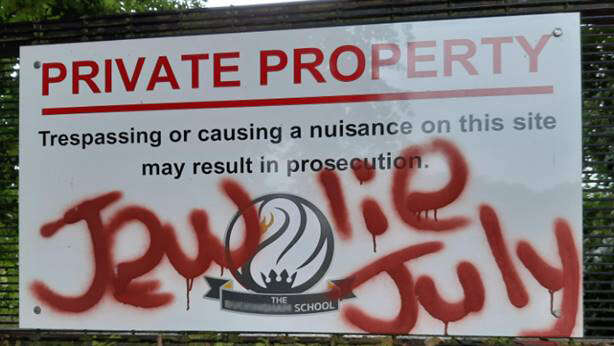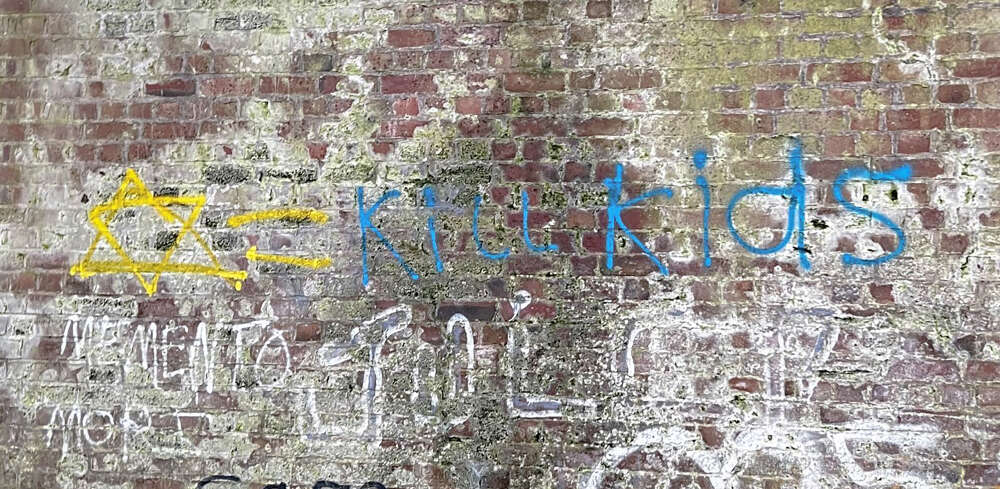Contents
Antisemitic Incidents 2024
Executive summary

CST recorded 3,528 antisemitic incidents in the UK in 2024, the second-highest total ever reported to CST in a single calendar year. This is a decrease of 18% from the 4,296 anti-Jewish hate incidents recorded by CST in 2023, which remains the record annual total ever reported, and was fuelled by responses to the 7 October terror attack by Hamas on Israel that year. CST recorded 1,662 antisemitic incidents in 2022, 2,261 in 2021, and 1,684 in 2020.1
- Although the 3,528 anti-Jewish hate incidents recorded in 2024 is a fall from the all-time high of 2023, it remains an unusually large total: 56% higher than the third-highest annual figure of 2,261 incidents reported in 2021. It is a reflection of the sustained levels of antisemitism that have been recorded across the UK since the Hamas terror attack in Israel on 7 October 2023. CST’s Antisemitic Incidents Report 2023 charted the immediacy and scope of the rise in anti-Jewish hate following that attack, before Israel had set in motion any extensive military response in Gaza.2 The subsequent ongoing war, and the public attention that it continues to hold, impacted both the volume and content of antisemitism in 2024.
- The three highest annual totals of antisemitic incidents, recorded in 2023, 2024 and 2021 respectively, have all been driven by anti-Jewish reactions to conflict in the Middle East. Of all these calendar years, 2024 is the only one for which war in the region lasted its entirety. CST recorded over 200 incidents in every month apart from December. Before October 2023, CST had only received more than 200 monthly reports of anti-Jewish hate five times, all of which coincided with wars involving Israel. February’s, January’s and March’s respective tallies of 446, 392 and 321 antisemitic incidents render them the fifth-, sixth- and seventh-worst months for anti-Jewish hate in the UK on CST’s record.
- The sheer quantity of incidents consistently recorded across the twelve months of 2024 shows two trends that are in line with CST’s previous analyses. First, that trigger events involving Israel spark antisemitic reactions in the UK: from those who celebrate attacks on Israel and Israelis via the method or language of anti-Jewish hate; those who target British Jews with their anger over this geopolitical issue; and those who exploit these occurrences as an opportunity to voice their preexisting, general anti-Jewish prejudice. Second, that when a trigger event such as the 7 October attack occurs, antisemitic incidents initially spike to a record peak; then gradually recede until they plateau at a higher level than before the original trigger event occurred. Hence, in the year leading up to 7 October, CST recorded an average of 154 cases of anti-Jewish hate per month; in 2024, this monthly average almost doubled, to 294 antisemitic incidents per month.
- The extended period of increased incident numbers partly reflects the unprecedented length of this particular conflict in Israel, Gaza and Lebanon, and its high profile in media and political debate throughout the entire year. Anti-Israel protests also continued throughout 2024 – albeit less frequently and with smaller attendance than in late 2023 – as have vigils for Israeli hostages held in Hamas captivity. This has not only ensured prolonged public interest in the subject matter, but has also provoked debate about antisemitism itself. These circumstances have contributed to an amplified uncertainty and fear among Jewish individuals and communities, who understand that they may become targetsby-proxy for anti-Israel enmity and, in turn, have more motivation to report anti-Jewish hate when they see it.
- The lasting impact of the conflict in the Middle East on anti-Jewish discourse in the UK is evident in the fact that rhetoric related to the conflict featured in 1,844 (52%) of the 3,528 antisemitic incidents reported to CST in 2024, alongside anti-Jewish language, motivation or targeting. In comparison, 43% of 2023’s incidents referenced or were linked to Israel, Palestine, the Hamas terror attack or subsequent war, most of which occurred after 7 October 2023. In 2022, a year unaffected by a significant trigger event in the Middle East, only 15% of the anti-Jewish hate incidents recorded were inflected with this discourse. There were 1,533 incidents in 2024 that showed explicitly anti-Zionist motivation alongside antiJewish language or targeting, comprising 43% of the annual total, compared to 31% in 2023. Variations on the terms “Zionism” or “Zionist” were used on 422 occasions, often as euphemisms for “Jewishness” and “Jew”, or in conjunction with other anti-Jewish sentiment, rising from 271 instances in 2023. At least 355 incidents were reported to CST wherein the phrase “Free Palestine” was employed in an antisemitic way. Although CST does not record uses of this phrase in and of itself as antisemitic, in each of these incidents, it was targeted at Jewish people or institutions in a hostile manner simply because they were Jewish, or comprised part of a larger tirade that involved explicitly anti-Jewish language.
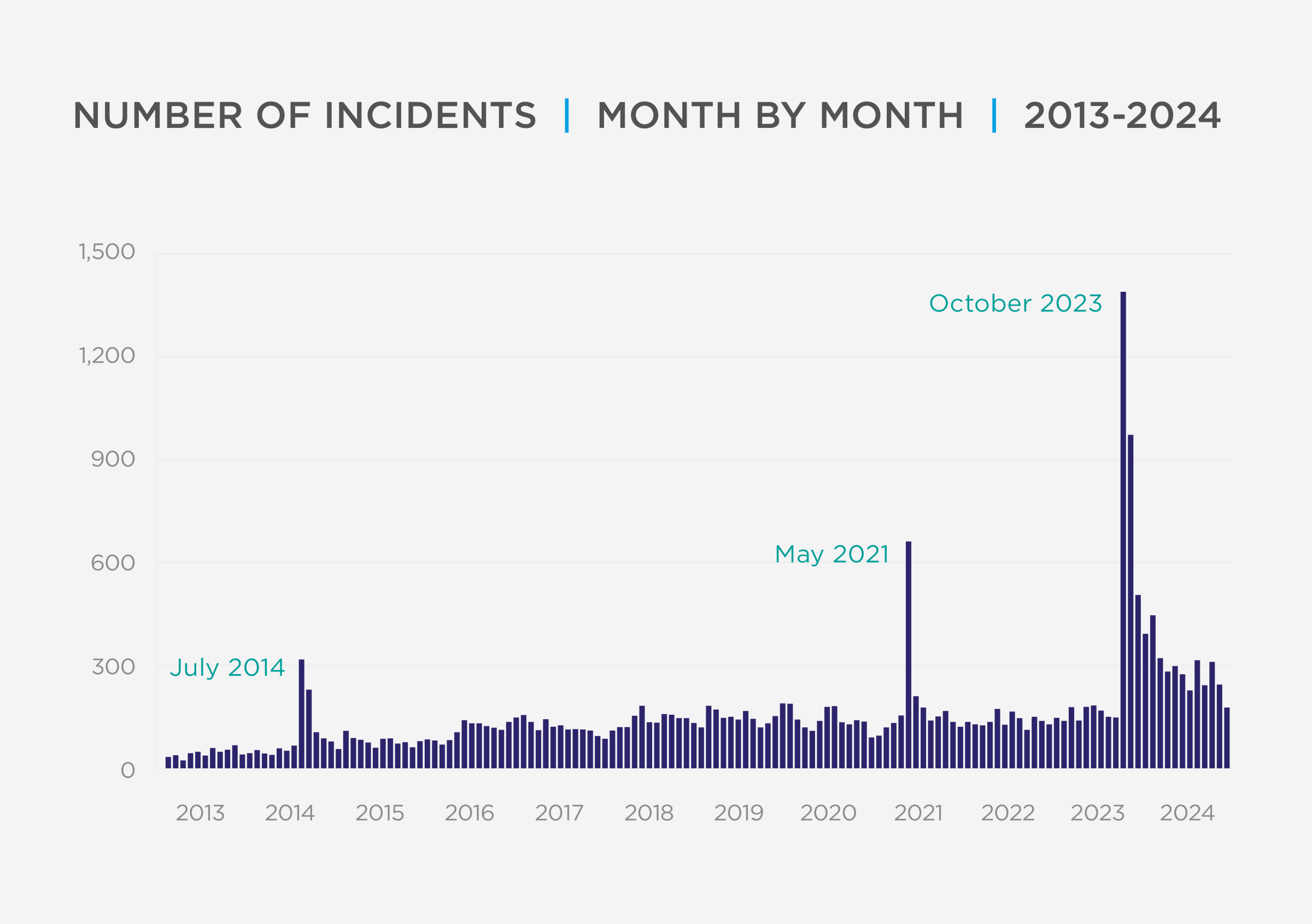
- One hundred and fifty-six antisemitic incidents recorded by CST in 2024 contained discourse relating to Islam, Muslims and Islamist groups, while 65 evidenced radical Islamist ideology. The former figure has risen from 129 incidents in 2023, while the latter has fallen from 88.
- In total, 2,589 (73%) of the 3,528 antisemitic incidents presented one or more political or ideological discourses, motivations, tropes or conspiracy theories. This was the case in 2,731 (64%) of the 4,296 incidents reported in 2023, and 834 (50%) of the 1,662 recorded in 2022. The rise in politicised language and motivations further demonstrates the impact of extremisms of different kinds on anti-Jewish hate in the UK. Meanwhile, 344 incidents, 10% of the annual total, combined two or more of these narratives. In 2023, this figure was 240, 6% of the overall figure. The coexistence of multiple rhetoric strands within the same incident reflects the complexity of contemporary antisemitism. Numerous stereotypes and myths about Jewish people are deeply embedded in collective and individual consciousness and shared by different extremist ideologies and movements, forming a library of reference points from which antisemites from distinct value systems can draw.
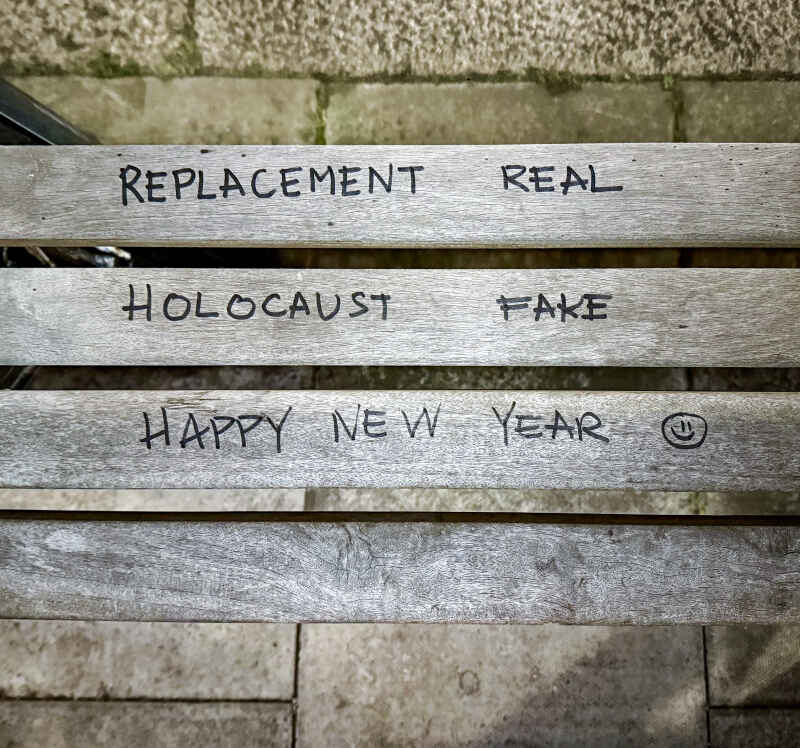
- CST recorded 201 incidents in the category of Assault in 2024, a decrease of 26% from 273 reported in 2023 and the second-highest total in this category for any calendar year. There was one additional incident severe enough to be classed as Extreme Violence (meaning it involved grievous bodily harm or a threat to life) whereas none did the previous year. Taken together, physical attacks on Jewish people constitute 6% of the annual total in 2024, the same as in 2023.
- Cases of Damage and Desecration to Jewish property fell by 19%, from 195 in 2023 to 157 in 2024, again the secondhighest annual figure in this category. Forty of these involved damage to the homes and vehicles of Jewish people, 37 to posters or memorials of Hamas’ victims, 19 to the property of Jewish businesses and organisations (including three to public chanukiahs – a candelabra used during the festival of Chanukah), 19 to synagogues, and eight to Jewish schools.
- There were 250 incidents reported to CST in the category of Threats in 2024, which includes direct threats and explicit incitement of violence to people, institutions or property, rather than general abuse containing non-specific threatening language. This is a decrease of 20% from the 314 incidents of this type recorded in 2023, making it this category’s secondhighest ever annual total.
- CST recorded 2,892 reports in the category of Abusive Behaviour in 2024, more than in any other year bar 2023 and a 17% fall from that year’s record of 3,491 such incidents. This figure eclipses every previous annual figure across all categories with the exception of 2023, and forms 82% of all cases of anti-Jewish hate reported to CST in 2024.
- There were 27 incidents reported to CST in the category of mass-produced antisemitic Literature in 2024, rising by 17% from 23 such incidents recorded in 2023.
- A high volume of anti-Jewish hate was reported in the school sector. In 2024, there were 63 antisemitic incidents recorded at Jewish schools, compared to 88 in 2023. A further 88 incidents involved Jewish schoolchildren away from school, often on their daily commute, compared to 111 incidents of this type reported in 2023. One hundred and nine incidents targeted Jewish schoolchildren or staff at non-faith schools, decreasing from 136 in 2023. This constitutes a total of 260 school-related cases of anti-Jewish hate in 2024, second only to 2023’s figure of 335. The breakdown of such incidents over the last two years is revealing: in 2024 and 2023, more incidents of anti-Jewish hate in the school sector occurred at non-faith schools than on schoolchildren’s commutes. In 2022, a year without a significant trigger event involving Israel, 41 incidents impacted pupils on their way to or from their place of education, and 37 took place at non-Jewish schools.
- Anti-Jewish hate was also recorded in high quantities in the higher education sphere. In 2024, 145 antisemitic incidents were reported to CST wherein the victims or offenders were students or academics, or which involved student unions, societies or other representative bodies. Of these, 66 occurred on campus or university property, and 65 took place online. While it is a decrease of 23% from the 189 such incidents recorded in 2023, when 68 happened on campus and 94 online, it remains the second-highest annual total for university-related antisemitic incidents in CST records. Of these 145 reports, 99 (68%) included references to Israel and the Middle East alongside anti-Jewish language, motivation or targeting, whereas this was the case for 52% of the incidents not linked to higher education.
- One hundred and sixty-four antisemitic incidents in 2024 targeted synagogues, including buildings, congregants and staff. Congregants on their way to or from prayers were victims in a further 59, compared to 157 and 50 respectively in 2023. This is a net rise of 8% in incidents affecting synagogues and the people travelling to, from, or already inside them, from 207 to 223 reports – the most that CST has ever recorded in a year. Synagogues are symbolic and often very visible targets for those seeking a target for their anti-Jewish hate. Fifty-eight (35%) of the 164 incidents directed at synagogues were hateful and threatening messages delivered by phone or email.
- CST recorded 1,240 cases of online antisemitism in 2024, the second-highest across any year and a decrease of 9% from the 1,360 online incidents reported in 2023. These incidents form 35% of the overall total, slightly more than 32% in 2023, and a jump from 22% in 2022. The numerical and proportional rises charted over the past two years are partly a consequence of the ongoing war in the Middle East, and the way this subject matter prompts discussion and debate on social media platforms. Sometimes, this dialogue slips into anti-Jewish discourse. Of these 1,240 incidents, 885 (71%) were directly related somehow to Israel and events in the region. This was true of just 959 (42%) of the 2,288 ‘offline’ cases of antisemitism reported in 2024.
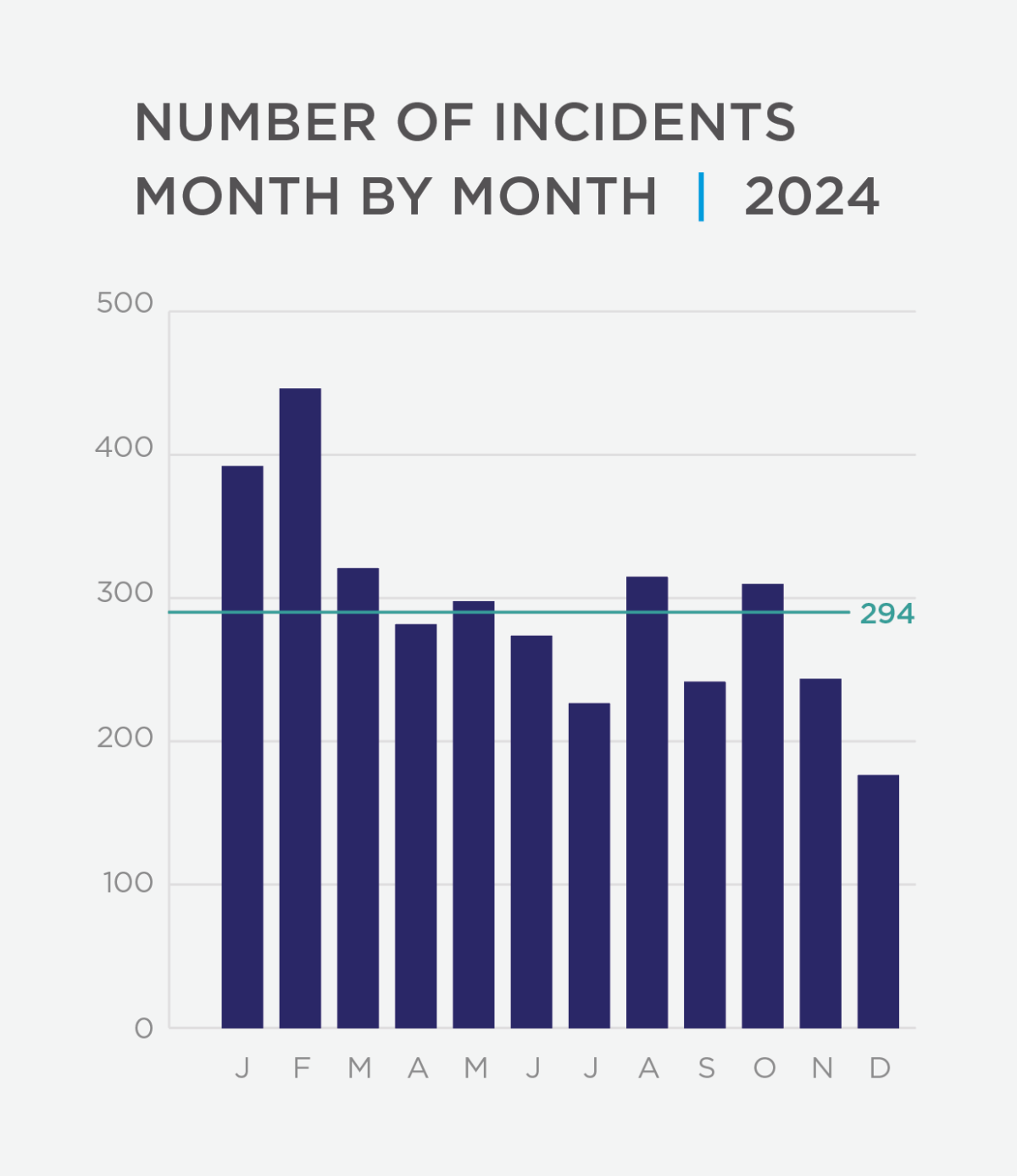
- This total for online incidents is only indicative, as the actual amount of antisemitic content that is generated and disseminated on online platforms is much larger. In some cases, social media has been used as a tool for coordinated campaigns of antisemitic harassment, threats and abuse directed at Jewish public figures and other individuals. Where this is the case, CST will record a coordinated campaign as a single incident, even if it involves multiple tweets, posts, messages or comments. CST does not trawl the internet looking for online incidents to log and will only record online incidents that are reported to CST by a victim, witness or other third party, and where either the offender or the victim is based in the UK.
- Online antisemitism formed the bedrock for the three highest daily totals of anti-Jewish hate reported to CST in 2024. CST recorded 45 antisemitic incidents on 15 February when CST published its Antisemitic Incidents Report 2023, 36 of which occurred online; 32 on 8 August when the Antisemitic Incidents Report January-June 2024 was released, 24 of which occurred online; and 30 on 29 February – 18 of which were online – when the government announced the extension of the Jewish Community Protective Security Grant that CST administers, in partnership with the Home Office, to pay for commercial security guards at synagogues and Jewish schools across the country. This means that 72% of incidents on the three worst days for antisemitism took place on virtual fora, proportionally more than double the 37% of incidents that happened in this space across the entire year, all of which were in response to news stories about increases in antisemitism. Issues of anti-Jewish hate and the need for community protection, when raised publicly, ignite reactions that perpetuate anti-Jewish prejudice, ironically making clear the necessity of such initiatives. In these instances, the anger manifests disproportionately online.
- In periods when the content and volume of anti-Jewish hate in the UK are affected by war in the Middle East, Holocaust-related discourse – which at other times is the most prevalent single narrative present in antisemitic incidents – is largely displaced by anti-Israel rhetoric. There were still 909 incidents reported to CST in 2024 where the Holocaust or Nazi era were invoked, comprising 26% of all incidents, falling from 1,001 cases in 2023 (23% of that year’s total). Among these 909 reports, there were 61 cases of Holocaust denial, compared to 70 in 2023, and 138 of Holocaust celebration, falling from 190 the previous year. On eight occasions, perpetrators simultaneously denied and glorified the Holocaust, showcasing the twisted logic and cognitive dissonance that can exist in the minds of those who hate Jews. Forty-six of the incidents celebrating the persecution of Jews under Nazi rule did so in the context of antiIsrael sentiment, usually lamenting Israel’s existence as a consequence of Hitler’s failure to exterminate the entirety of world Jewry, or expressing a desire for a repeat of the Holocaust due to Israel’s alleged actions. CST recorded 175 cases of antiJewish hate demonstrating explicit far-right ideological motivation, an increase from 154 incidents evidencing this form of extremism in 2023. Direct comparisons were drawn between Israel or Jewish people and the Nazis in 327 cases, up from 257 in 2023, joining together Holocaust and Israel-related discourses and counted among the tallies for each.
- Conspiracy theories were present in 487 (14%) of the 3,528 antisemitic incident reports in 2024, rising from 325 (8%) of the 4,296 incidents in 2023. From these, 345 spoke of malevolent Jewish manipulation of global politics, media, finance and other walks of life, compared to 268 in 2023. One hundred and eight involved lies regarding religious rituals and practices, rising from 40 in 2023. This specific, stark increase can be attributed to the Blood Libel myth, which has been given new life by antisemites who frame the tragic death of innocent Gazan children as a result of Jewish lust for infant blood.
- There were 100 incidents in which specific aspects of Judaism were attacked or deliberately mischaracterised to antisemitic ends, nearly double the 58 cases of this kind recorded in 2023. Of these, 45 manipulated ideas and stories taken from religious scripture (over the 21 reported in 2023); 39 targeted religious holy books (compared to 18 in 2023); and 16 focused on religious traditions (21 in 2023). On 332 occasions, anti-Jewish hate was expressed through stereotypes, dehumanising language or caricatures, a rise from 179 in 2023.
- In 2024, a year that included a general election, CST recorded 70 incidents connected to specific political parties or their supporters. 3 Fifty of these were linked to the discussion around the Labour Party: a small increase from 2023, when 45 incidents were Labour Party-related.4 Thirty-nine of these 50 instances of anti-Jewish hate also made reference to the Middle East. There were two antisemitic incidents associated with the Conservative Party (equal to 2023’s total), one with the Liberal Democrats and one with the Green Party, seven with the Socialist Workers Party, one with the National Housing Party UK, and seven with independent parliamentary candidates and councillors (all of which had no related incidents in 2023). Nine of these 70 politically motivated incidents took place between the announcement of the general election on 22 May and the confirmation of the election results on 4 July.
- CST recorded 1,847 antisemitic incidents in Greater London, falling by 24% from the 2023 total of 2,441 London-based incidents. Four hundred and eighty cases of anti-Jewish hate were reported in Greater Manchester, a decrease of 13% from 556 incidents in the corresponding area in 2023. In both regions, these are the second-highest annual incident figures on record, and they comprise 66% of the national total, whereas they formed 70% in 2023. These communal hubs are where the majority of the UK’s Jewish population resides, and are consistently the principal targets of anti-Jewish prejudice.
- CST recorded 1,847 antisemitic incidents in Greater London, falling by 24% from the 2023 total of 2,441 London-based incidents. Four hundred and eighty cases of anti-Jewish hate were reported in Greater Manchester, a decrease of 13% from 556 incidents in the corresponding area in 2023. In both regions, these are the second-highest annual incident figures on record, and they comprise 66% of the national total, whereas they formed 70% in 2023. These communal hubs are where the majority of the UK’s Jewish population resides, and are consistently the principal targets of anti-Jewish prejudice.
- Within Greater London, 791 antisemitic incidents occurred in Barnet, the local authority with the largest Jewish community in the UK. There were 213 instances of antisemitism recorded in Westminster, 170 in Camden, 96 in Hackney and 56 in Brent. The figure for Greater London would be higher, were it not for a technical problem from March onwards that disrupted the flow of reports received from the Metropolitan Police as part of CST’s information exchange with police forces. CST’s collaboration with police is of huge value, and remains a core component of CST’s daily work.
- Incident totals in Westminster have ranked higher within Greater London’s statistics ever since 7 October 2023 than in previous years. Westminster is the country’s political centre, and has played host to many of the capital’s anti-Israel demonstrations and vigils for Hamas’ victims. While mostly peaceful events, they have attracted individuals reported to CST for anti-Jewish placards and hate speech. At least 28 antisemitic incidents took place in Westminster either at, or in transit to or from, anti-Israel marches or vigils for the hostages.
- Of Greater Manchester’s 480 antisemitic incidents, 161 occurred in the City of Manchester, 129 in Bury, 115 in Salford, 26 in Trafford and 16 in Stockport.
- The only police constabularies within which CST did not record a single antisemitic incident in 2024 were Lincolnshire and Suffolk. Anti-Jewish hate manifests across the UK and, with the potential amplification provided by online platforms, can now find articulation and reach regardless of proximity to visible Jewish communities.
- Apart from Greater London and Greater Manchester, the police regions with the highest numbers of recorded antisemitic incidents in 2024 were West Yorkshire with 184 incidents (up from 165 in 2023); Hertfordshire with 117 (113 in 2023); Scotland with 74 (68 in 2023); Thames Valley with 65 (43 in 2023); and West Midlands with 63 (equal to 2023’s total).5
- Aside from boroughs in Greater London and Greater Manchester, the cities and towns in the UK where anti-Jewish hate was most frequently reported were Leeds in West Yorkshire (129 incidents); Borehamwood & Elstree in Hertfordshire (49 incidents); Birmingham in West Midlands (47 incidents); Brighton & Hove in Sussex (43 incidents); and Liverpool in Merseyside (38 incidents).
- There were 950 incidents reported to CST in 2024 in which the victims were ordinary Jewish individuals in public. In at least 495 incidents, they were visibly Jewish on account of their traditional clothing, Jewish school uniforms, jewellery and insignia bearing religious symbols, or presence at public Jewish events. In 2023, this was true of 989 and 416 incidents respectively.
- Thirty-one antisemitic incidents were related to places of work and professional online fora in 2024, rising from 26 such incidents in 2023, while Jewish businesses and organisations – four of which were youth movements – were targeted on a record 652 occasions, rising by 31% from the 498 incidents of this kind in 2023. Of these 652 reported cases, 546 (84%) occurred online, 500 (77%) contained discourse relating to the conflict in the Middle East, and 139 (21%) involved allegations of Jewish interference in, and power over, various world affairs.
- A record 179 instances of anti-Jewish hate were reported to CST in 2024 wherein the victim was an individual of public prominence, an increase of 23% from the 145 incidents of this nature reported in 2023. Of these, 170 (95%) took place online, 136 (76%) referenced Israel and circumstances in the Middle East, and 53 (30%) indulged in the myth of global Jewish control. These totals convey the extent to which public figures and communal bodies, both Jewish and non-Jewish, are collectively held responsible for Israel’s alleged behaviour. In some cases, they are accused of selling their political integrity to Israel, which draws on the antisemitic conspiracy theory that Jews use financial muscle to wield power throughout society.
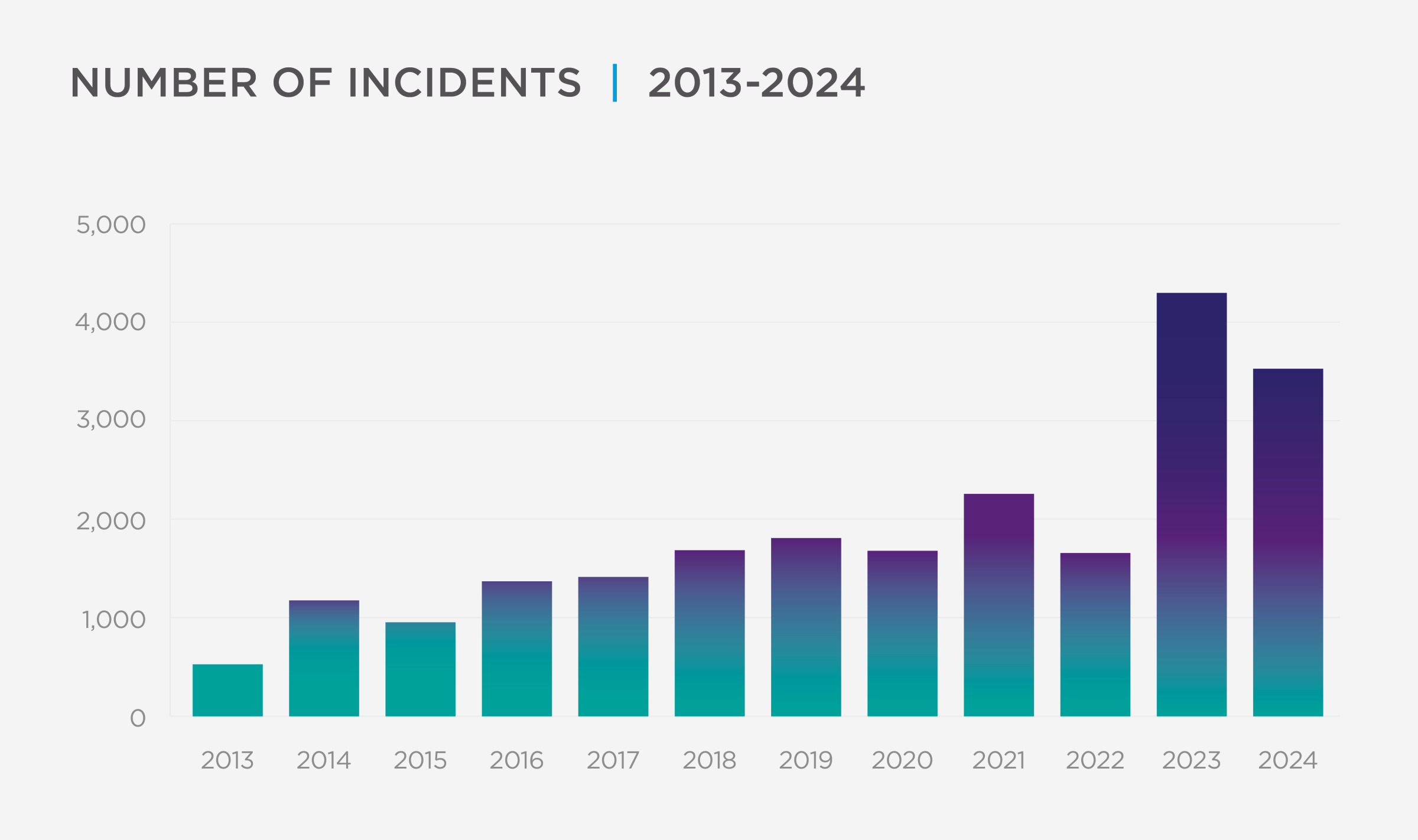
- There were 165 incidents that took place at people’s residential properties or affected parked vehicles in 2024, a small decrease from 180 incidents of this type in 2023. Fifty-six of these were perpetrated by a neighbour or somebody with a prior relationship to the victim, forming part of the 233 cases of anti-Jewish hate where this was the case: just over the 232 such incidents recorded in 2023 but a larger proportion of the annual figure. Ninety-three (40%) of these “interpersonal” incidents used rhetoric referencing Israel and the war. It demonstrates how, in the context of conflict in the Middle East, personal relationships can be damaged, whether between classmates, colleagues, neighbours and friends.

- There were 24 antisemitic incidents reported to CST in 2024 that took place in the context of professional football, falling from 43 such incidents in 2023.6 Reports of anti-Jewish hate in grassroots or amateur football also marginally fell, from 19 incidents in 2023 to 17 in 2024. A further two incidents occurred in other amateur sporting environments: one in a basketball match, and one in a tennis game.
- CST received a description of the victims’ gender in 1,753 of the 3,528 antisemitic incidents recorded in 2024. Of these, 946 (54%) were male; 653 (37%) were female; two (<1%) were non-binary; and in 152 incidents (9%), the victims were mixed groups of males and females.
- The sustained high levels of antisemitism reported in the school sector correlate with an increase in the proportion of children amongst incident victims in general. Of the 1,773 instances in which the victim or victims’ age was ascertained by CST, 279 (16%) targeted victims exclusively under the age of 18. A further 110 incidents (6% of the incidents where victim age was given) impacted mixed groups of adults and minors, meaning children were among the victims in 22% of reports of anti-Jewish hate in 2024. This proportion has been on the rise since 2020, when the victims were exclusively children in 8% of incidents, and a combination of adults and minors in a further 3%. These figures were 14% and 4% respectively in 2021, 15% and 5% in 2022, and 17% and 4% in 2023.
- CST will ask incident victims or witnesses if they can describe the person, or people, who committed the incident they are reporting. Interactions between perpetrators and victims may be crude and brief, leaving little reliable information, and while it is often possible to receive reports regarding the apparent appearance or motivation of incident offenders, this is not absolute proof of the offenders’ actual ethnic or religious identity, nor of their motivation. In addition, many incidents do not involve face-to-face contact between offender and victim, so there is no physical description of the offender. With these caveats, CST does provide data regarding the ethnic appearance, age and gender of incident offenders.
- CST obtained a description of the ethnic appearance of the offender or offenders in 1,241 of the 3,528 antisemitic incidents reported during 2024. Of these, 570 (46%) were described as white – North European; 33 (3%) as white – South European; 121 (10%) as black; 160 (13%) as South Asian; seven (1%) as Southeast Asian; and 350 (28%) as Arab or North African. This breakdown is close to that reported in 2023, but diverges from what is typically reported in years when UKbased antisemitism is largely unaffected by events in the Middle East. For example, in 2022, 51% of perpetrators were described as white – North European; 5% as white – South European; 16% as black; 10% as South Asian; less than 1% as Southeast Asian; and 18% as Arab or North African. This demographic shift matches that witnessed during Israel-related conflicts in previous years, when antisemitic incident offenders of North African, Arab or South Asian appearance were more highly represented than usual.
- A description of the gender of the offender or offenders was provided to CST in 2,015 of the 3,528 antisemitic incidents recorded in 2024. Of these, the offenders were described as male in 1,565 incidents (78% of incidents where the offender’s gender was obtained); female in 388 incidents (19%); and mixed groups of males and females in 62 incidents (3%).
- In 1,856 of the 3,528 reports of antisemitism in 2024, the approximate age of the offender or offenders was given. Among these, 1,549 (84%) involved adult offenders, 35 of which involved adults described to be over the age of 65; in 304 cases (16%), the perpetrators were minors; there were three instances where the offenders were a mix of adults and children.
- In addition to the 3,528 antisemitic incidents recorded in 2024, a further 2,479 potential incidents were reported to CST that are not included among this report’s statistics as, upon investigation, they did not evidence antisemitic motivation, language or targeting. Many of these incidents involve suspicious activity or possible hostile reconnaissance at Jewish locations, and they play an important role in CST’s provision of protection to the Jewish community. This total of non-incidents also includes ordinary anti-Israel rhetoric and activism that does not meet CST’s threshold for classifying as antisemitic. It is the highest number of non-antisemitic incidents that CST has ever recorded in a year, rising from 2,230 in 2023, and reflects the general increase in anti-Israel rhetoric throughout the year as war in the Middle East has persisted. It also reflects a Jewish community that has felt a heightened sense of uncertainty and fear, and therefore may be more inclined to report any perceived hostile activity.
Introduction
Community Security Trust Community Security Trust (CST) is a UK charity that advises and represents the Jewish community on matters of antisemitism, terrorism, policing and security. CST received charitable status in 1994 and is recognised by government and the police as a best practice model of a minority community security organisation. CST provides security advice and training for Jewish schools, synagogues and Jewish communal organisations and gives assistance to those bodies that are affected by antisemitism. CST also assists and supports individual members of the Jewish community who have been affected by antisemitism and antisemitic incidents. All this work is provided at no charge. An essential part of CST’s work involves representing the Jewish community to police, legislative and policymaking bodies and providing people inside and outside the Jewish community with information to combat antisemitism. CST has recorded antisemitic incidents in the United Kingdom since 1984.
Definition of antisemitic incidents The statistics in CST’s annual Antisemitic Incidents Report include antisemitic hate crimes and antisemitic non-crime hate incidents. CST defines an antisemitic incident as any malicious act aimed at Jewish people, organisations or property, where there is evidence that the act has antisemitic motivation or content, or that the victim was targeted because they are (or are believed to be) Jewish. This is a narrower definition than that used by the criminal justice system, which defines an antisemitic hate incident as “Any non-crime incident which is perceived by the victim or any other person, to be motivated by a hostility or prejudice based on a person’s race/religion or perceived race/religion.” 7 The International Holocaust Remembrance Alliance (IHRA) working definition of antisemitism is a useful guide in identifying the different types of antisemitic language that may be used in an incident.
Antisemitic incidents can take several forms, including physical attacks on people or property, verbal or written abuse, hate mail (including antisemitic emails), antisemitic leaflets and posters, or abuse and comments on social media. CST does not include the general activities of antisemitic organisations in its statistics. CST does not record as incidents antisemitic material that is permanently hosted on websites or that is published by mainstream media, nor does CST trawl social media platforms to look for antisemitic comments. CST will, however, record antisemitic comments or posts from internet forums or transmitted via social media, if they have been reported to CST by a member of the public who fulfils the role of a victim or witness; if the comment shows evidence of antisemitic content, motivation or targeting; and if the offender is based in the UK or has directly targeted a UK-based victim.8
Reporting antisemitic incidents Antisemitic incidents are reported to CST in several ways, most commonly by telephone, email, via the CST website, via CST’s social media platforms, by post or in person to CST staff and volunteers. CST staff have undergone specialist training in order to provide the best possible response to incident victims and witnesses who contact CST.
Incidents can be reported to CST by the victim, a witness, or by someone acting on their behalf. In 2001, CST was accorded ‘Third Party Reporting’ status by the police, which allows CST to report antisemitic incidents to the police and to act as a go-between for victims who are unable or unwilling to report to the police directly. CST works closely with police services and specialist units in monitoring and investigating antisemitic incidents. CST regularly exchanges anonymised antisemitic incident reports with police forces around the United Kingdom under a national Information Sharing Agreement that was signed with the National Police Chiefs’ Council (NPCC) and with individual police constabularies.9
It is likely that many, and perhaps even most, antisemitic incidents are not reported either to CST or to the police. However, the Home Office’s latest report on hate crime in England and Wales acknowledges that a combination of a genuine rise in hate crime and growing public awareness of what it means – as well as police accuracy in correctly recording them – is leading to a higher number of reports than when they started collating data in 2013.10
If an incident is reported to CST but shows no evidence of antisemitic motivation, language or targeting, then it will not be recorded asantisemitic and will not be included in CST’s annual antisemitic incident total. In 2024, CST received 2,479 reports of potential incidents that fit this description, rising by 11% from the 2,230 such incidents recorded in 2023; itself a very large increase from 2022’s total of 621. Many of these potential incidents involve suspicious activity or possible hostile reconnaissance at Jewish locations; criminal assaults on or theft from Jewish people that do not show antisemitic motivation; or anti-Israel activity that did not involve the use of antisemitic language or imagery and was not directed at Jewish people, buildings or organisations chosen solely because they were Jewish. The increase observed from 2022 is a consequence of the substantial rise in antiIsrael feeling being publicly communicated since 7 October 2023, and the Jewish community’s generally heightened sense of distress and unease amidst the surge in antisemitism recorded since Hamas’ attack on Israel. These factors have led to more reports of any activity perceived as potentially hostile, even if they do not meet CST’s threshold to be classed as an antisemitic incident. These reports still play an important role in CST’s provision of security protection to the Jewish community.
The increase observed from 2022 is a consequence of the substantial rise in anti-Israel feeling being publicly communicated since 7 October 2023
CST always prioritises the wishes and needs of incident victims, both individuals and the heads of Jewish organisations or communal buildings. CST especially treats the issue of victim confidentiality as a top priority. If an incident victim chooses to remain anonymous or wishes there to be no publicity about an incident, CST will respect their request as far as possible.
CST recorded 3,528 antisemitic incidents across the UK in 2024, the second-highest figure that CST has ever recorded in a single calendar year. This constitutes a fall of 18% from the record 4,296 incidents reported to CST in 2023. CST received 1,662 reports of anti-Jewish hate in 2022, 2,261 in 2021, and 1,684 in 2020.
Figures, trends & context The total of 3,528 antisemitic incidents recorded in 2024 may be a decrease from the figure reported in 2023, but it is still an unusually large total and 56% higher than 2021’s total of 2,261 incidents, which is the third-highest yearly figure ever reported. The 2024 total is a result of the enduring levels of anti-Jewish hate observed in the UK since the Hamas terror attack on Israel on 7 October 2023. In its immediate aftermath, while news of the attack was still filtering around the world, CST recorded a substantial and unprecedented spike in antisemitism across the country, which occurred before Israel had conducted any extensive military response in Gaza. The war that consequently unfolded, its continuation through the months since and the prominence it has maintained for the media and general public, affected the quantity and content of anti-Jewish hate throughout 2024.
Whenever Israel is at war, there is an impact on the volume of antisemitism in the UK. The three highest annual totals, reported to CST in 2023, 2024 and 2021, were all prompted by anti-Jewish responses to such trigger events. However, 2024 was the first time that an Israelrelated conflict lasted an entire calendar year, and this is reflected in the recorded monthly figures. CST logged over 200 antisemitic incidents in every month aside from December. Before October 2023, this had only happened on five occasions, all of which correlated with periods when Israel was at war. The 446, 392 and 321 incidents reported respectively in February, January and March make them the fifth-, sixth- and seventh-worst months for UK-based anti-Jewish hate ever recorded by CST. These three months immediately followed the three worst months on CST’s record in descending order: October, November and December 2023. This pattern demonstrates the sustained impact, for over a year, of reactions to the conflict in Israel and Gaza on anti-Jewish hate in Britain.
The consistently elevated levels of antisemitism seen around the country since October 2023 and across 2024 reinforce two conclusions that CST has previously drawn in 40 years of recording anti-Jewish hate. First, that affairs in the Middle East concerning Israel drive hostility in the UK that is targeted at its Jewish community. This may come from people who are excited and inspired by violent attacks on Israel and its citizens; from people who consider British Jews as legitimate proxy targets for their anger towards Israel; and from people who use Israel as an excuse to vent their pre-existing, unrelated prejudice against Jews. Second, that when there is an Israel-related catalyst for an escalation in antisemitism, incidents quickly surge to a record spike before plateauing at a higher rate than was typical prior to the trigger event. This trend is evident from previous patterns of antisemitic incidents at times of Middle East conflict, even after the initial peaks observed during the periods of warfare. For example, in the year before the war in Gaza and Israel in late 2008/early 2009, CST recorded an average of 46 incidents per month, compared to an average of 51 between March 2009 and February 2010. Similarly, in the year preceding the summer war in 2014, CST recorded an average of 52 incidents per month, which rose to 82 in the year after the fighting had ended. The short conflict in May 2021 saw the average increase again from 134 incidents per month in the year’s lead-up, to 143 incidents per month across the year after. In this current context, CST recorded an average of 154 cases of anti-Jewish hate per month in the year leading up to 7 October 2023; in 2024, this average almost doubled, to 294 incidents per month.
While the pattern has repeated, the scale of its current iteration is far larger. This is partly a consequence of the elongated time scale of this war in comparison to previous episodes, and the fact that, while it began with the 7 October terror attack on southern Israel and then Israel’s response in Gaza, Israel has since had to fight on numerous borders. The topic has therefore gripped a greater amount of public attention and opinion for a greater amount of time, with images of the devastation of war constantly circulating on mainstream and social media platforms. Meanwhile, anti-Israel marches persisted throughout 2024 – albeit less often and with dwindling attendance compared to late 2023 – as have vigils for the hostages held by Hamas. These factors have guaranteed that the subject matter has remained firmly in public consciousness for a prolonged amount of time. While this attention is not invalid or inherently antisemitic, there is an historic correlation between levels of anti-Jewish hate and intensified public and media focus on Israel-related conflicts.
This focus has brought the very notion of antisemitism under heightened scrutiny, with its definition and, in some cases, validity as a critical concept contested. The idea that antisemitism is a made-up construct used to dismiss criticism of Israel itself draws on the antisemitic trope that Jewish people falsely claim victimhood and manipulate it for their own social and political advantage.
The environment engendered by these various factors has exacerbated the feelings of anxiety, uncertainty and fear that the Jewish community has felt since the 7 October attack. When considering the high levels of anti-Jewish hate explored in this analysis, one must appreciate that as well as the evidenced increase in antisemitic incidents, this environment has probably motivated Jewish people to report those incidents in greater numbers than before.
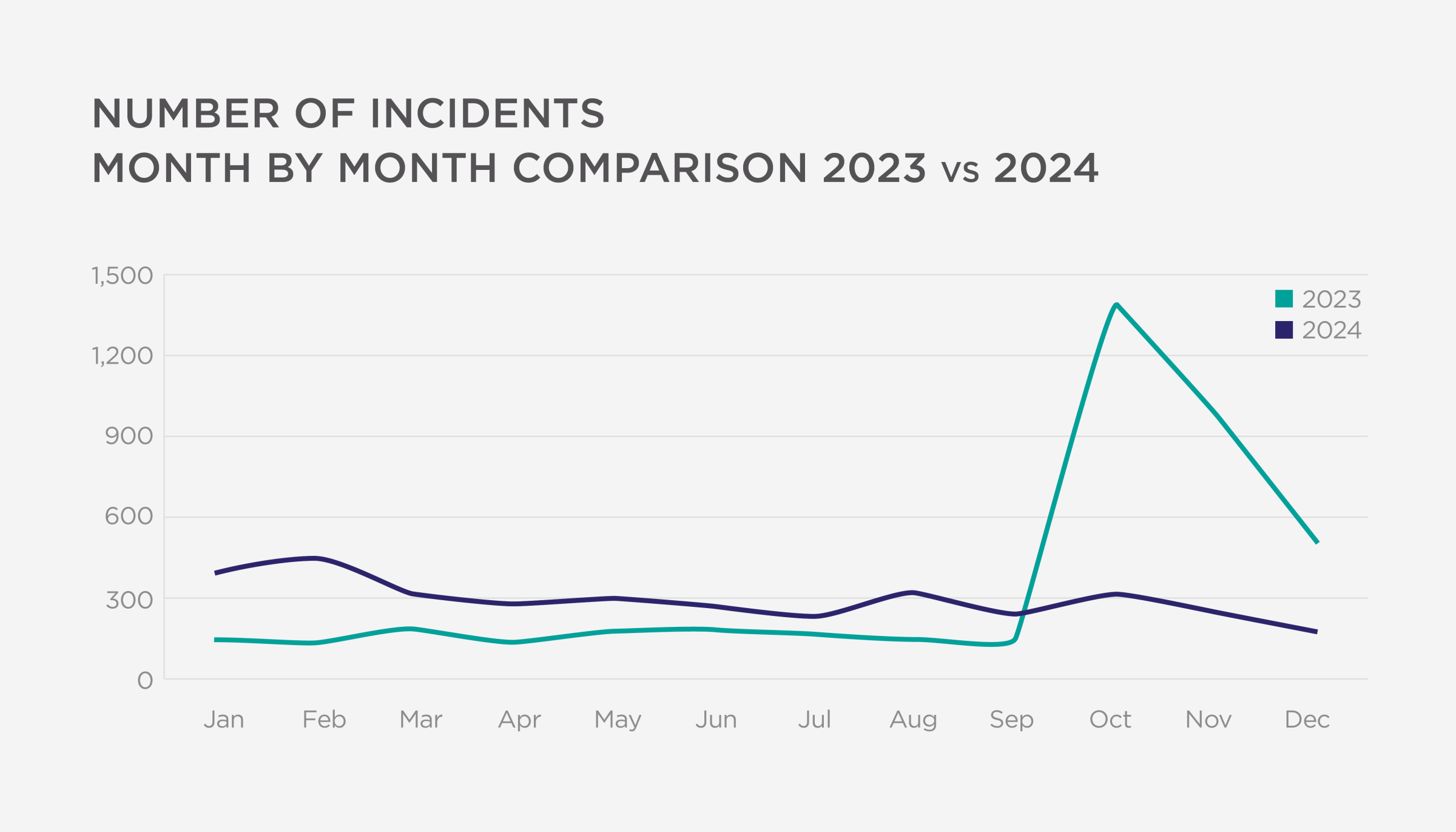
The influence of war in the Middle East on the content of anti-Jewish hate in the UK is clear in the 1,844 incidents reported to CST in 2024 that contained Israel-related discourse alongside anti-Jewish language, motivation or targeting. This was the single predominant type of language observed, evident in 52% of the antisemitic incidents recorded in 2024. For comparison, there were 1,832 such incidents reported in 2023 (43% of that year’s total), and 246 (15% of the annual figure) in 2022: the most recent year without a trigger event in the Middle East. This also impacted the volume, percentage and language of online antisemitism logged by CST in 2024. Of the 3,528 antisemitic incidents reported in 2024, 1,240 happened online, comprising 35% of the annual total. This is a decrease in number but increase in proportion of the whole from 2023, when 1,360 cases of online hate formed 32% of the annual total. Of the 1,240 instances of online antisemitism reported to CST in 2024, 885 (71%) involved references to the Middle East; whereas this was the case in 959 (42%) of the 2,288 ‘offline’ incidents recorded in 2024. The disparity between the two demonstrates the prevalence of conflict-related discourse found in online antisemitism. Meanwhile, at least one political, religious and antisemitic discourse, conspiracy theory, stereotype or ideology of all types was evident in 1,122 (90%) of the online incidents, compared to 1,467 (64%) of the ‘offline’ incidents. The online space is therefore proportionally more likely to host politicised and extremist anti-Jewish hate. On social media and other virtual platforms, antisemites are able to share their prejudice with other like-minded individuals, under a cloak of anonymity if they so desire. Here, hatred is expressed, validated and easily directed wherever they choose, too often without meaningful repercussion from those responsible for moderating these fora’s content.
CST recorded 716 antisemitic incidents on X in 2024, more than on all other online fora combined. One hundred and thirty-five cases of abuse occurred via email; 117 on Facebook; 116 via text or instant messaging services, including those associated with social media platforms; 70 on Instagram; 13 on TikTok; four on video conferencing platforms; three on Snapchat; two on YouTube; one involved an anti-Jewish comment posted under an online article; one involved the hacking of a Jewish organisation’s printer; and 62 happened on a range of other virtual sites. These figures only reflect the number of reports to CST involving each platform or medium, rather than being an assessment or approximation of the relative amount of antisemitism on each.
Of the 1,240 online cases of anti-Jewish hate reported to CST in 2024, 1,153 fell into the category of Abusive Behaviour, 75 were classed as Threats, 11 as Literature and one – the printer hacking – as Damage & Desecration. In 272 instances, the perpetrator employed antisemitic memes, images, graphics or cartoons.
In 2024, the highest daily incident totals were in large part due to mass online expressions of antisemitism. There were 45 cases of antiJewish hate reported to CST – 36 online – on 15 February, the release date of CST’s Antisemitic Incidents Report 2023. Thirty-two incidents – of which 24 were online – were recorded on 8 August, the release date of CST’s Antisemitic Incidents Report January-June 2024. On 29 February, CST logged 30 incidents – 18 of which were online – when the government announced the extension of the Jewish Community Protective Security Grant that CST administers, in partnership with the Home Office, to pay for commercial security guards at synagogues and Jewish schools across the country. In total, on the three worst days for antisemitism in 2024, all of which coincided with news stories about increases in antisemitism and the necessity of security for the Jewish community, 72% of incidents took place on social media and other online spaces. Across all other days, just 37% of incidents happened virtually. When the related issues of anti-Jewish hate and the need for the physical protection of Jewish life are raised in the public domain, it elicits the kind of reactions that justify the urgency of these conversations and initiatives. These reactions manifest disproportionately online, often directed at Jewish organisations that have commented on the news, meaning also that they are more likely to be reported as incidents.
CST records each specific targeted campaign as a single incident, because to record each piece of antisemitic online content as a separate incident would be unsustainable and cause extreme variations in CST’s incident totals, obstructing clear analysis. It is also worth bearing in mind that the number of online incidents in this report reflects the number of reports received by CST from victims, witnesses or other third parties, and does not include the vast amount of antisemitic material unearthed, sifted and investigated by CST’s researchers as part of its wider work protecting the Jewish community from potential attack. Given the vast array of material posted and the variety of platforms across which it is circulated, an accurate figure for the actual amount of antisemitic content on social media would be impossible to quantify. Instead, this total highlights that online platforms continue to be a fertile ground for public expressions of antisemitism, sometimes culminating in coordinated campaigns against Jewish public figures and institutions.
It is sometimes difficult to gauge whether these historically high antisemitic incident figures observed by CST are due to more incidents taking place in the UK, or the fact that people feel more comfortable, able and aware to report incidents to CST. The answer is likely to be a combination of both, although sometimes, as in the aftermath of Hamas’ terror attack on Israel, it is clear that there has been a genuine rise in anti-Jewish hate that is initiated by a specific set of circumstances. A less tangible factor behind the general increase observed is the possible impact that the prevalence of media coverage and public debate about antisemitism may inadvertently have on actual hate actors. If there is a perception that the taboo against articulating hostility about or towards Jewish people is weakening, then antisemites might feel that they are far from alone in this prejudice, and be more likely, perhaps, to have confidence in sharing their views.
Despite improvements in reporting, it is expected that antisemitic hate crimes and hate incidents are underreported, especially where the victims are minors or the incident is considered of ‘lesser’ impact by the victim. The statistics contained in this report should therefore be seen as indicative of general trends, rather than absolute measures of the number of incidents that took place. Answering why antisemitic incidents take place is not simple. Victim or witness evidence for what may have been a brief, traumatic experience can be vague and disjointed. Many incidents do not have a specific victim and the offender is often unknown, but it is still possible to analyse the data contained in the individual reports received by CST, and the picture they show is complex. In short, there is no single profile of an antisemitic incident victim or offender, nor is there a single explanation as to why antisemitism persists in modern society.
Incident categories
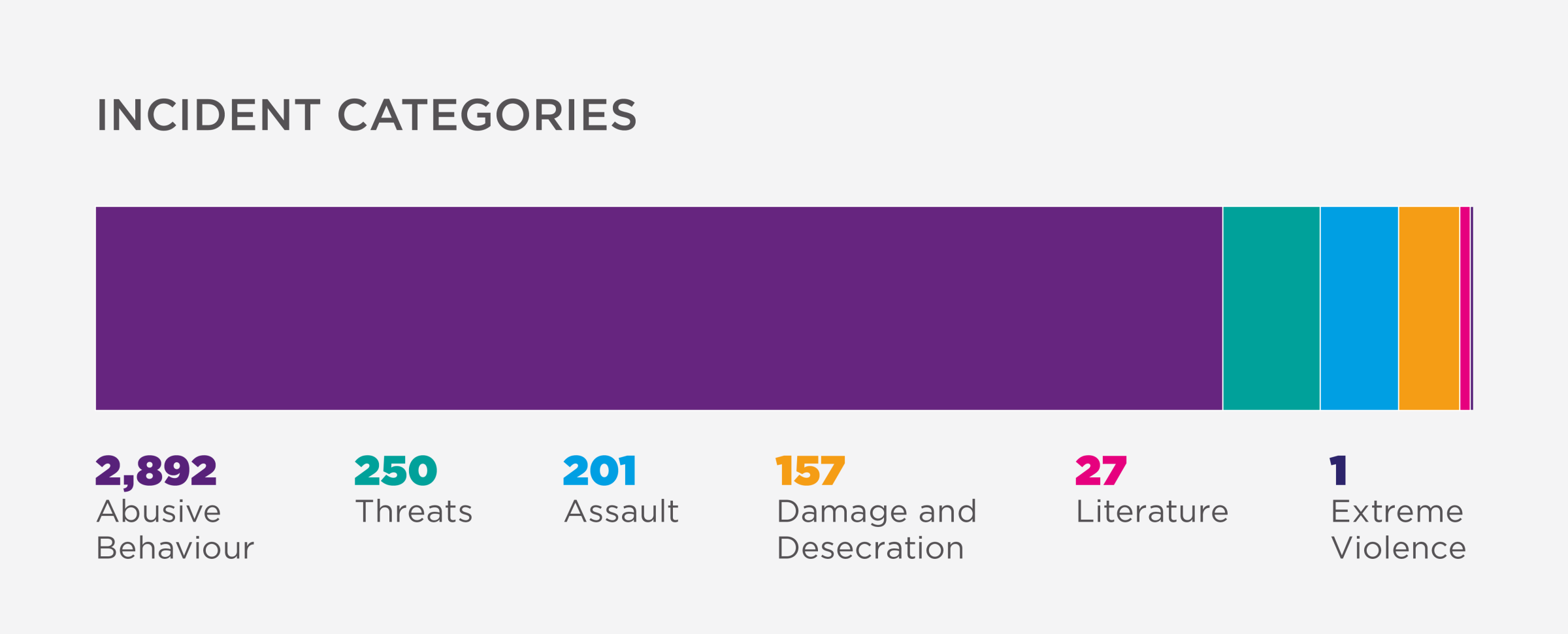
Extreme Violence
Incidents of Extreme Violence include any antisemitic attack with the potential or intention of causing loss of life or grievous bodily harm (GBH). CST recorded one instance of Extreme Violence in 2024, compared to none in 2023. One incident of this kind was reported in 2022, three in 2021, and three in 2020. This single report in 2024 involved alleged arson at a residential property.
Assault
Incidents of Assault include any physical attack against a person or people, which does not pose a threat to their life or cause GBH, but instead may be considered actual bodily harm (ABH) or common assault. This includes attempted assault, even if it fails, and spitting or throwing objects at Jews, including where the projectile misses its target.
CST recorded 201 incidents in the category of Assault in 2024, a fall of 26% from the 273 assaults reported in 2023, and the secondhighest ever annual total in this category. There were 136 assaults logged by CST in 2022, 174 in 2021, and 97 in 2020. In 56 of the 201 incidents of this type in 2024, the offender punched or kicked the victim. In 37 instances, stones, bricks, eggs, bottles or other projectiles were thrown at the victim, launched on 20 occasions from a passing vehicle. In 34 cases, the victim was spat at, and the perpetrator removed their religious clothing (such as a skullcap, or kippah) or accessories in 21 instances. In five incidents, the perpetrator deployed a non-lethal firearm and, on a further five occasions, used their vehicle to physically endanger pedestrians. In four instances, a stick or other weapon was employed, while three incidents involved a knife, one saw an attempted window smashing with the victim inside their car, and there was one record of fireworks thrown at a synagogue with people inside. One hundred and twenty-six of these violent incidents were accompanied by verbal abuse, and 18 contained an element of threatening language.
Physical attacks constitute 6% of the overall incident total, equal to the percentage reported in 2023, whereas before Hamas’ attack on Israel, Assault formed 8% of the overall incident total. This dipped to 5% immediately after the Hamas attack, suggesting that the sustained high volume of anti-Jewish hate in the UK since 7 October 2023 has been expressed more frequently through verbal or written abuse, threats and acts of vandalism, and less often through acts of violence than before.
Of the 202 cases of Assault and Extreme Violence, 89 (44%) occurred across just four UK boroughs: Barnet (48) and Hackney (15) in Greater London, and Bury (11) and Salford (15) in Greater Manchester. In comparison, 1,042 (31%) of the 3,326 non-violent incidents reported to CST in 2024 took place in these areas and it remains the case that, consistent with CST’s past analyses, physical attacks on the Jewish community are more likely to take place in the areas where Jewish life is most established and visible than other categories of anti-Jewish hate. The presence of these communities, identifiable by various signifiers of religion and tradition, may be perceived by the offender as an existential threat to what they consider their own culture and territory. Perhaps the public prominence of religious symbols makes it easier for antisemites to dehumanise, degrade and desecrate Jewish people and places as being so distinct from their own. They may also simply provide the perpetrator with a certainty of who and what they are attacking, and the opportunity for maximum gratification. Indeed, in at least 99 (49%) of these 202 violent antisemitic incidents, the targets were visibly Jewish, usually on account of their religious insignia, traditional clothing or Jewish school uniform.
Alarmingly, a higher proportion of children were involved in incidents classed as Assault than in other categories. Of the 170 reports of Assault where CST obtained the victim or victims’ age, minors were attacked in 61 cases (36%).11 Of the 143 assaults wherein the approximate age of the perpetrator was provided, 43 (30%) were described as being under the age of 18. Across the other categories of antisemitic incidents, children were recorded as victims in 20% and offenders in 15%. The relatively higher involvement of children in incidents of Assault correlates with and perpetuates trends logged since 2021, a previous year when an escalation in violence between Israel and Hamas sparked a surge in school-based antisemitism. This trend has continued in the context of the current war. Thirty-two (16%) of the physical antisemitic attacks reported to CST in 2024 were perpetrated by minors against minors.
CASE STUDY
Assault in central Manchester
In August, a visibly Jewish man was walking in central Manchester when a man described as being of Arab or North African appearance approached him from behind and kicked him in the leg. The victim turned around to see his attacker walking away, and said, “Why did you do that?” The offender replied, “You kill Palestinians”. He added, “If you come near me, I’ll kill you”, when the victim attempted to catch up with him.
Damage & Desecration to Jewish Property
This category includes any physical attack directed against Jewish-owned property, or property that is perceived to be connected to Jews, which is not life-threatening. This includes the daubing of antisemitic slogans or symbols (such as swastikas) – including fixing stickers and posters – on Jewish property; damage caused to property where it appears that the property has been specifically targeted because of its perceived Jewish connection, or where antisemitic expressions are made by the offender while causing the damage; and the hacking of Jewish websites and social media accounts with antisemitic material, or where the site has been targeted specifically because of its relevance to the Jewish community. As this type of incident is usually only seen after the act has been completed, it is often very difficult to get any information about the perpetrators.
There were 157 instances of Damage & Desecration to Jewish property recorded by CST in 2024, the second-highest annual total in this category and a drop of 19% from 195 incidents of this type reported in 2023. There were 74 antisemitic incidents recorded in this category in 2022, 82 in 2021, and 74 in 2020. Forty of these incidents saw damage done to the homes and vehicles of Jewish people, 37 to posters or memorials in tribute to Hamas’ victims,12 19 to the property of Jewish businesses and organisations (including three to public chanukiahs – a candelabra used during the festival of Chanukah), 19 to synagogues, and eight to Jewish schools.
In 58 of the 157 instances of Damage & Desecration, the offender used graffiti, daubing, stickers or posters of an antisemitic nature to deface the Jewish target. Thirty-six of these were related to events in the Middle East, with anti-Jewish messaging explicitly written in 37 cases. Eggs, stones, bricks, bottles or other projectiles were thrown at Jewish property to cause damage on 23 occasions, and three times from a passing vehicle. CST recorded 11 cases involving the destruction or removal of a mezuzah (a Jewish prayer scroll affixed to a building’s entrance), nine incidents resulting in broken windows, five where non-kosher food was left at Jewish premises or deliberately placed within the kosher food aisle at supermarkets, four in which the offender spat at Jewish property, two where Jewish property was set alight (but not at the risk of physical injury), one each involving damage caused by a metal bat, hammer and stick, and one wherein the door of a Jewish home was smashed down. CST recorded one additional example in which the printers at a Jewish-owned business were hacked and used to print anti-Israel documents. All included some element of anti-Jewish focus, language or imagery to be recorded among these figures by CST.
CASE STUDY
Sticker on public chanukiah
In December, a sticker with the words “FREE PALESTINE” was plastered onto a public chanukiah in Stockport.

Threats
This category includes only direct antisemitic Threats, whether verbal or written. This would include potential improvised explosive devices (IEDs) that were designed to be hoaxes rather than IEDs that are intended to be viable. CST recorded 250 direct antisemitic Threats in 2024, the second-highest annual total in this category, falling by 20% from the 314 incidents of this kind reported in 2023. One hundred and three incidents were recorded for this category in 2022, 143 in 2021 and 85 in 2020.
Seventy-nine of the 250 Threats took place in public, while Jewish businesses and organisations – one of which was a youth camp – were targeted in 32 cases. Threats were directed at synagogues in 21 instances and, on one occasion, at congregants on their way to a prayer service. Meanwhile, Jewish people were threatened while at home in 15 instances, there were 12 Threats made in the sphere of higher education, and public figures were threatened in 11 incidents. Ten direct Threats were made to Jewish schools, six to Jewish pupils on their commute to or from their place of education, and six within the confines of non-faith schools. Seventy-five of the incidents in this category involved written threats in online platforms, 37 were delivered via phone call or message, nine via post, and there were 20 bomb threats made.13
CASE STUDY
Threatening email to a synagogue in Dorset
In August, a Dorset synagogue received an email with threats to kill. It read:
“my name is [redacted], I’m 25 and have a big hate for jew’s for what they have done to our people in palestine, killing innocent children & family’s, now i will take revenge for what your people have done.
Tomorrow morning, I will come down and gun down all you Jewish fat loser one by one, I will become Hitler on that early morning, I hope you think I’m joking so you do not inform anyone to save you filthy humans, in the name of Allah i will destroy all of you... watch.” [sic]
Abusive Behaviour
Within the umbrella of Abusive Behaviour falls a wide range of incident types, including everything encompassed by verbal and written antisemitic abuse other than direct threats. The category also includes antisemitic emails, text messages, social media posts and comments, as well as targeted antisemitic letters (that is, one-off letters aimed at and sent to a specific individual), irrespective of whether the recipient is Jewish. This is different from a mass mailing of antisemitic leaflets, pamphlets or group emails, which is dealt with by the separate Literature category. The verbal abuse can be face-to-face or via telephone calls and voicemail messages. Antisemitic graffiti on non-Jewish property is also included in this category.
There were 2,892 incidents reported to CST in the category of Abusive Behaviour in 2024, comprising 82% of the 3,528 annual total and signalling a fall of 17% from the 3,491 instances of Abusive Behaviour recorded in 2023: the only year in which more incidents of this kind were reported. These 2,892 incidents are more than the overall figures recorded across all categories in every year besides 2024 and 2023. There were 1,339 incidents of Abusive Behaviour in 2022, 1,849 in 2021, and 1,413 in 2020.
In 698 of the Abusive Behaviour incidents reported in 2024, the victims were Jewish people in public, and identifiably so in at least 316 cases. Jewish organisations and businesses were targets of 595 incidents in this category, while public figures – Jewish and non-Jewish – were subjected to antisemitic abuse on 166 occasions. One hundred and ninety-eight of these incidents were related to the school sector, 116 to the university sector, and 158 to the synagogue sector. On 98 occasions, victims were harassed in their own homes, and in the workplace on 28 occasions.
Among the 2,892 incidents of Abusive Behaviour, 1,150 involved spoken abuse and 1,195 written abuse, while 156 contained generally threatening or intimidating language without making a direct threat. There were 419 cases of antisemitic graffiti, daubing, posters or stickers on non-Jewish property. Two hundred and sixty-seven of these cases of damage to non-Jewish property depicted a swastika or contained Nazi-era references, 159 were related to Israel and the Middle East, and an additional 77 combined these discourses. In 320 cases, anti-Jewish images, memes or cartoons were used to cause offence. Three hundred and sixteen incidents in this category involved offensive shouts or gestures in public, 252 of which emanated from passing vehicles. There were 108 abusive phone calls or voice messages made, and 33 counts of one-off hate mail that were not known to be part of a mass mailing.
Of the 2,892 reports in this category, 1,153 occurred online, constituting 40% of the category’s total and 93% of the 1,240 online incidents recorded across all categories. The annual totals for online antisemitic abuse, second only in quantity to those reported in 2023, serve as a reminder of the pivotal role that social media and instant messaging platforms play in the production, dissemination and amplification of contemporary anti-Jewish hate. Antisemites have the opportunity to find like-minded people on these spaces, who affirm and encourage their shared worldview, and they are provided with the tools to project their prejudice as far as they want at the click of a button, with the potential for total anonymity should they so desire. As long as the companies responsible for these virtual fora do not prioritise online safety, antisemitism will continue to spread there.
This responsibility is doubly important because, when such vitriolic hatred is expressed in these spaces, it is not confined to the online world. Every abusive post, comment, message, meme and video carries the capacity to incite and inspire offline anti-Jewish activity, while simultaneously weakening the taboo against publicly demonstrating hatred towards Jewish people. When this taboo is perceived to be diminishing, antisemitism will manifest more freely both online and offline. The proliferation of angry online debate, discussion, information and misinformation surrounding war in the Middle East cannot be disentangled from the sustained high levels of anti-Jewish hate in the UK since 7 October 2023.
CASE STUDY
Abuse at school in Essex
In November, CST received a report of ongoing antisemitism at a school in Essex. The victim had been targeted on repeat occasions by the same classmate, who had said things such as, “I hope you get gassed”, “I hope we can go back to the old times in the 1940s”, and “Heil Hitler”. He had also made Nazi salutes to the victim between classes.
Literature
This category covers mass-produced antisemitic literature that is distributed in multiple quantities. This can involve a single mass mailing or repeated individual mailings, but it must involve the multiple use of the same piece of literature in order to fall into this category. This is different from one-off cases of hate mail targeted at individual people or organisations, which would come under the category of either Abusive Behaviour or Threats. This category includes literature that is antisemitic in itself, irrespective of whether or not the recipient is Jewish, and cases where Jews are specifically targeted with malicious material, even if the content itself is not antisemitic. This would include, for instance, the mass mailing of neo-Nazi literature targeted at Jewish organisations or homes, even if the literature did not mention Jews. This category also includes antisemitic emails and online posts that are sent to groups of recipients. The statistics for this category give no indication of the extent of distribution. A single mass mailing of antisemitic literature is only counted as one incident, although it could involve material being sent to dozens of recipients. Thus, the number of incidents reflects the number of offenders and their actions, rather than the number of victims.
There were 27 incidents reported to CST in this category in 2024, an increase of 17% from 23 incidents of this type recorded in 2023. CST recorded nine instances of Literature distribution in 2022, ten in 2021, and 12 in 2020.
Eleven of these 27 incidents occurred online. In nine cases, antisemitic emails were sent to multiple synagogues, Jewish schools and organisations, and/or individuals. Meanwhile, antisemitic comments were repeatedly targeting Jewish organisations or individuals on two occasions: once on Facebook and once on Instagram. Of the 16 offline incidents in this category, eight involved mass-distributed anti-Jewish leaflets, while mass-produced posters and stickers were put up in public in four instances. There were two examples of antisemitic hate mail, and multiple people had a fake bank card posted through their doors titled Israeli Holocaust Card. Finally, there was one report of an edition of Oliver Twist prescribed as school reading material in which Fagin was illustrated with the features of an overtly antisemitic caricature.
CASE STUDY
Antisemitic leaflets in Scotland
In May, a series of antisemitic leaflets were seen in northern Scotland. They were produced by the Goyim Defence League and claimed that “Every Single Aspect Of Feminism Is Jewish”, with photos of various feminist figures and a pink Star of David superimposed onto their faces.14

Incident victims
The victims of antisemitic incidents come from the whole spectrum of the Jewish community: from strictly orthodox to liberal, reform and secular Jews; from the largest Jewish communities to small, isolated communities across the UK; from Jewish schoolchildren to Members of Parliament. Occasionally, antisemitism will also be directed at people who do not identify as Jewish.
There were 950 incidents reported to CST in 2024 in which the victims were ordinary Jewish individuals in public. In at least 495 incidents, they were visibly Jewish on account of their traditional clothing, Jewish school uniforms, jewellery, insignia or other items bearing religious symbols, or their presence at public Jewish events. In 2023, this was true of 989 and 416 incidents respectively. There was an element of verbal abuse in 1,434 of the 3,528 incidents recorded by CST in 2024, 215 of which incorporated threatening language. In 366 cases, anti-Jewish hate was shouted or gestured by random strangers in public who, on 292 occasions, did so from a vehicle. This captures the most common type of in-person incident reported to CST since the organisation began compiling statistics: the random, unprovoked, verbal or signalled harassment of individuals who are presumed for whatever reason to be Jewish, as they go about their daily lives in public.
The language and frequency of this type of incident are noticeably influenced when Israel is at war. Of the 1,434 instances of verbal abuse recorded in 2024, 656 were explicitly motivated by war in the Middle East. In at least 273 of these cases, the phrase “Free Palestine” was employed, targeting random Jewish people in public on 182 occasions. While this phrase is not in itself an antisemitic expression and would not, in isolation, be treated by CST as an antisemitic incident, in these circumstances, when it is specifically deployed to harass Jewish people and organisations for no other reason than their perceived Jewishness, “Free Palestine” takes on the role and purpose of an antisemitic slogan.
In 2024, there were 63 antisemitic incidents recorded at Jewish schools, compared to 88 in 2023. An additional 88 incidents involved Jewish schoolchildren away from school premises, usually on their way to or from home, compared to 31 in 2023. CST recorded 109 incidents involving Jewish schoolchildren or staff at non-faith schools, falling from 136 in 2023. This results in a total of 260 incidents affecting people and buildings in the school sector, the second-highest number of incidents that CST has ever recorded in this sector, and a decrease of 22% from the 335 such incidents reported in 2023.
Of these 260 incidents, 26 came under the category of Assault, 23 of which involved Jewish schoolchildren attacked on their commute, and three saw Jewish schoolchildren targeted by their classmates at non-faith schools; 12 incidents were classed as Damage & Desecration to Jewish property; there were 22 direct Threats made (ten to Jewish schools, six to Jewish pupils at non-faith schools, and six to schoolchildren on their way to or from school); 198 incidents were classed as Abusive Behaviour; finally, two incidents were recorded as mass-produced antisemitic Literature.
In years when events in the Middle East have a reduced effect on anti-Jewish hate in the UK, reports of antisemitism at non-faith schools are less common than the other types of school-related incidents recorded by CST. For example, in 2022, there were 41 incidents that affected schoolchildren on their commute, and 37 that took place at non-Jewish schools. The shift observed in 2023 and 2024, wherein antisemitism in non-faith school environments has become the predominant single kind of school-based incident reported to CST, is a sign of international events affecting behaviour within British schools, while also reflecting wider communal anxieties about the safety of Jewish children in those schools.
High levels of anti-Jewish hate were also observed in higher education. In 2024, 145 antisemitic incidents affected Jewish students, academics, student unions or other student bodies, or were perpetrated by individuals in the university sector. It is a fall of 23% from the 189 such incidents recorded in 2023, but nevertheless is the second-highest total for university-related antisemitic incidents ever reported to CST in a calendar year. Of these 145 incidents, six were classified as Assault, ten as Damage & Desecration, 12 as Threats, 116 as Abusive Behaviour, and one as Literature. Sixty-six of them took place on campus or university property (compared to 68 in 2023), and 79 away from campus, of which 65 were online (down from 94 in 2023).
Ninety-nine (68%) of these 145 incidents were overtly related to Israel and the Middle East. This proportion is significantly higher than amongst incidents that did not happen in the university sector, where 52% of incidents showed this kind of discourse. This disparity cannot be explained by any single reason, but there are aspects of university life that may be relevant when assessing why the topic of Israel is disproportionately prevalent in the antisemitic incidents observed in these settings. The longstanding tradition of student anti-Israel activism can contribute to an environment in which some individuals react to war in the region with antisemitism: a consequence perhaps driven by the desire to belong to a cause, and the proliferation of simplistic, antagonistic online content around what is a complex and dense subject matter. This interpretation does not intend to excuse or absolve antisemitic incident offenders in these settings of responsibility, nor to delegitimise ordinary political activism, but to illuminate the way that these phenomena can contribute towards an atmosphere in which harassment and abuse of Jewish students can occur.
There were 164 antisemitic incidents recorded in 2024 that targeted synagogues (including buildings, congregants and staff while at the location), exceeding 2023’s total of 157 by 4%. A further 59 incidents saw prayergoers targeted on their way to or from services, up by 18% from 50 incidents of this kind reported in 2023. This constitutes a record annual total of 223 synagoguerelated incidents, a net rise of 8% from 2023’s figure of 207 such cases. Seventeen of these reports fell into the category of Assault, while 20 involved the Damage & Desecration of synagogue property. There were 22 cases of direct Threats made (21 to Jewish places of worship and one to congregants in public), 158 classified as Abusive Behaviour, and six as Literature. On 58 occasions, synagogues were targeted with abuse via hostile phone calls, voice messages or emails. One hundred and two (46%) of the 223 antisemitic incidents recorded in the synagogue sector contained Israel-related rhetoric. A synagogue is a place of Jewish prayer and communal activity, and the most visible symbol of a Jewish presence in any neighbourhood. As such, an attack on a synagogue is not a political statement against Israel, but an assault on Jewish life in the United Kingdom. From life, to death: one incident reported to CST in 2024 targeted a Jewish cemetery.
Thirty-one incidents were related to the workplace, rising by 19% from the 26 reports of this kind in 2023. Meanwhile, a record 652 incidents targeted Jewish businesses and organisations – including youth movements on four occasions – a rise of 31% from the 498 such cases in 2023. Jewish communal organisations, including CST, have continued to speak out about the levels of anti-Jewish hate witnessed in the UK since 7 October 2023, drawing hate from those who hold Jewish institutions somehow complicit in events in the Middle East, particularly online. Of the 652 antisemitic incidents targeting Jewish community organisations, 546 (84%) happened online, 500 (77%) contained Israel-related discourse, and 139 (21%) contained allegations of disproportionate Jewish power in the world. The highest daily totals in 2024 correlated with significant public announcements from CST, which other Jewish organisations also shared on their social media feeds. On 15 February, CST recorded 45 incidents – of which 34 targeted Jewish organisations – when CST published its Antisemitic Incidents Report 2023. On 8 August, CST logged 32 cases of anti-Jewish hate – of which 18 targeted Jewish organisations – upon the release of its Antisemitic Incidents Report JanuaryJune 2024. On 29 February, 30 antisemitic incidents were reported – of which 15 targeted Jewish organisations – when the government announced the extension of the Protective Security Grant that pays for commercial security guards at Jewish schools and synagogues across the country, which CST co-administers with the Home Office.
There was also a record number of antisemitic incidents targeting people of public prominence reported to CST in 2024. One hundred and seventy-nine cases of anti-Jewish hate were directed at high-profile individuals, rising by 23% from 145 such incidents in 2023. As with the incidents affecting Jewish businesses and organisations, a large proportion of these happened in the virtual space and were related to events in the Middle East: 170 (95%) took place online, while 136 (76%) referenced Israel. Meanwhile, 53 (30%) included theories about Jewish control over various walks of life. These numbers show how public figures and institutions in the UK – Jewish and non-Jewish – are held responsible for the circumstances in the Middle East. In some cases, they are alleged to be collaborators in a global Jewish conspiracy, or mere vessels for Israel’s alleged agenda. Their presence on social media platforms augments their accessibility and, with it, their vulnerability to receiving anti-Jewish prejudice.
In 2024, 165 incidents reported to CST occurred at people’s residential property or affected their parked vehicles. This is a drop of 8% from 180 incidents of this kind reported in 2023. Fifty-six of these were perpetrated by a neighbour or somebody with a prior relationship to the victim, forming part of the 233 cases of antisemitism wherein the offender was known to the victim prior to the incident. It is a slight increase from the 232 such instances of “interpersonal” hate recorded in 2023, comprising a larger percentage of the overall figure. Of these incidents, 93 (40%) involved rhetoric linked to events in the Middle East. These statistics, influenced by the high levels of anti-Jewish hate recorded in nonJewish schools, universities and workplaces, demonstrate how the impact of some people’s reactions to the conflict in the Middle East can directly affect personal relationships in Britain.
There were 24 antisemitic incidents reported to CST in 2024 that were in some way related to professional football, falling by 44% from 43 such incidents recorded in 2023. Of these, seven involved anti-Jewish hate observed within a stadium, four in a non-stadium environment, and 13 were online incidents. CST recorded a further 17 incidents in the context of grassroots or amateur football, falling slightly from 19 incidents of this kind in 2023. There were two additional reports of antisemitism that occurred at amateur level in other sports: one in a basketball match, and one in a tennis game.
CST received a description of the victims’ gender in 1,753 of the 3,528 antisemitic incidents recorded in 2024. Of these, 946 (54%) were male; 653 (37%) were female; two (<1%) were non-binary; and in 152 incidents (9%), the victims were mixed groups of males and females.
The victim or victims’ age was ascertained in 1,773 of the antisemitic incidents reported to CST in 2024. Of these, 1,384 (78%) involved adult victims, of which 34 cases involved adults over the age of 65; 279 (16%) involved victims who were minors; in 110 instances (6%), mixed groups of adults and minors were targeted. The total proportion of incidents involving child victims – 22% of incidents wherein CST was provided with the victim or victims’ age – has been growing since 2020, when the victims were exclusively children in 8% of incidents, and a combination of adults and minors in a further 3%. These figures were 14% and 4% respectively in 2021, 15% and 5% in 2022, and 17% and 4% in 2023. It correlates with the sustained volume of antisemitism reported in the school sector, which is particularly acute when Israel is at war.
Incident offenders
It is not always easy to ascertain the ethnicity, gender or age of antisemitic incident offenders. Many face-to-face incidents involve fleeting, nonverbal, public encounters in which the offenders may not be fully visible or leave the scene quickly. Victim and witness testimonies may be vague and disjointed, which is understandable given the nature of the ordeal that they have experienced. Many incidents do not involve face-to-face contact, and it is therefore not always possible to obtain a physical description of the perpetrator. Furthermore, those who commit antisemitic offences online may choose to completely anonymise themselves, which makes it almost impossible to garner any information about the person behind the abuse. On the other hand, if social media profiles are not anonymised, they can provide some personal details of offenders, such as a name, photograph or approximate location.
While it is possible to collect data regarding the ethnic appearance of incident offenders, this data is not direct evidence of the offenders’ religious affiliations. The content of an antisemitic letter may reveal the motivation of the offender, but it would be a mistake to assume the ethnicity or religion of a hate mail sender solely on the basis of the discourse they employ.
CST received a description of the ethnic appearance of the offender or offenders in 1,241 of the 3,528 antisemitic incidents recorded in 2024. Of these, 570 (46%) were described as white – North European; 33 (3%) as white- South European; 121 (10%) as black; 160 (13%) as South Asian; seven (1%) as Southeast Asian; and 350 (28%) as Arab or North African. These percentages are broadly similar to those logged in 2023 and in 2021, but differ from the usual breakdown recorded in years when anti-Jewish hate is less impacted by wars involving Israel. For example, in 2022, when there was no trigger event involving Israel, 51% of perpetrators were described as white – North European; 5% as white – South European; 16% as black; 10% as South Asian; less than 1% as Southeast Asian; and 18% as Arab or North African. When prevailing events in the Middle East affect the volume and content of antisemitism in the UK, this is reflected in increased numbers and proportions of incident perpetrators who are described to CST as being of North African, Arab or South Asian appearance. It is important to bear in mind that these details rely on the subjective judgement of witnesses and victims, made in what can be brief, disorientating encounters.
A description of the gender of the offender or offenders was obtained in 2,015 of the 3,528 antisemitic incidents reported in 2024. Of these, the offenders were described as male in 1,565 incidents (78% of incidents where the offender’s gender was obtained); female in 388 incidents (19%); and mixed groups of males and females in 62 incidents (3%). As with reported perpetrator ethnicities, these proportions are consistent with those recorded in 2023, but diverge from those logged during the previous year. In 2022, 82% of incidents had a male offender, 16% a female offender, and 2% mixed groups of males and females. Once again, the context of ongoing war in the Middle East may be relevant in assessing the reasons for this change. In 2024, of the 388 recorded cases of anti-Jewish hate perpetrated exclusively by females, 65% contained rhetoric relating to Israel, Palestine and events in the region, while 58% were explicitly anti-Zionist. For incidents featuring exclusively male offenders, these figures were 55% and 44% respectively. There is no clear reason why women might be more likely than men to incorporate anti-Israel or anti-Zionist language in their antisemitic hate speech in the incidents recorded by CST.
In 1,856 of the 3,528 reports of antisemitism in 2024, the approximate age of the offender or offenders was given. Among them, 1,549 (84%) involved adult offenders, 35 of which were perpetrated by adults described to be over the age of 65; in 304 cases (16%), the perpetrators were minors; there were three instances (less than 1%) where the offenders were a mix of adults and children. These percentages are in keeping with the averages recorded since 2021, when the escalation in conflict between Israel and Hamas initiated a surge in anti-Jewish hate perpetrated by schoolchildren: levels which remained elevated during the intervening years and during the current war.
Antisemitic or anti-Israel
CST is often asked about the difference between antisemitic incidents and anti-Israel activity, and how this distinction is made in the categorisation of incidents. The difference between the two can be subtle and the subject of much debate. Clearly, it would not be acceptable to define all anti-Israel speech and action as antisemitic. Nevertheless, it cannot be ignored that contemporary antisemitism can occur in the context of, or be accompanied by, extreme feelings over the Israel/Palestine conflict, and that hostility towards Israel may be expressed via, or motivated by, antisemitic rhetoric and conspiracy theories. Discourse relating to the conflict is used by antisemitic incident offenders to abuse Jews, and anti-Israel discourse can sometimes repeat, or echo, antisemitic language and imagery. For example, the terms “Zionist” and “Zionism” will often be used in arguments about Israel and the Middle East; sometimes they are used accurately and legitimately, and at other times they are deployed in an antisemitic way. CST must distinguish between the occasions when these terms are used in a purely political sense, and the times when they are abused as euphemisms for “Jewishness” and “Jew”. Similarly, the phrase “Zionist Lobby”, when it is reserved for Jewish organisations and individuals regardless of whether they have taken a public stance on Zionism, walks the line between the conspiracy theory that Jews have a disproportionate political power and influence, and the antisemitic trope that Jews have a ‘dual loyalty’ or are not to be trusted.
Drawing out these distinctions and deciding on where the dividing lines lie is one of the most difficult areas of CST’s work in recording and analysing hate crime.
Sometimes the targeting of a particular incident can suggest an intention to intimidate or harass Jews on the part of the offender. For example, if anti-Israel posters or graffiti appear to have been deliberately placed close to a synagogue or other Jewish building, or in an area with a large Jewish population, then they are more likely to be classified as an antisemitic incident if their location indicates an intention to harass and intimidate the Jewish community. If anti-Israel material is sent unsolicited to a synagogue or other clearly Jewish venue at random then it may well be recorded as an antisemitic incident (because the synagogue was targeted on the basis of it being Jewish and the offender has failed to distinguish between a place of worship and pro-Israel political activity). Similarly, if cars draped in Palestinian flags are driven through the heart of Jewish communities, or shouts of “Free Palestine” or comments and questions demanding an opinion on the Middle East are directed at Jewish people – simply because they are perceived to be Jewish – it will also be considered an antisemitic incident.
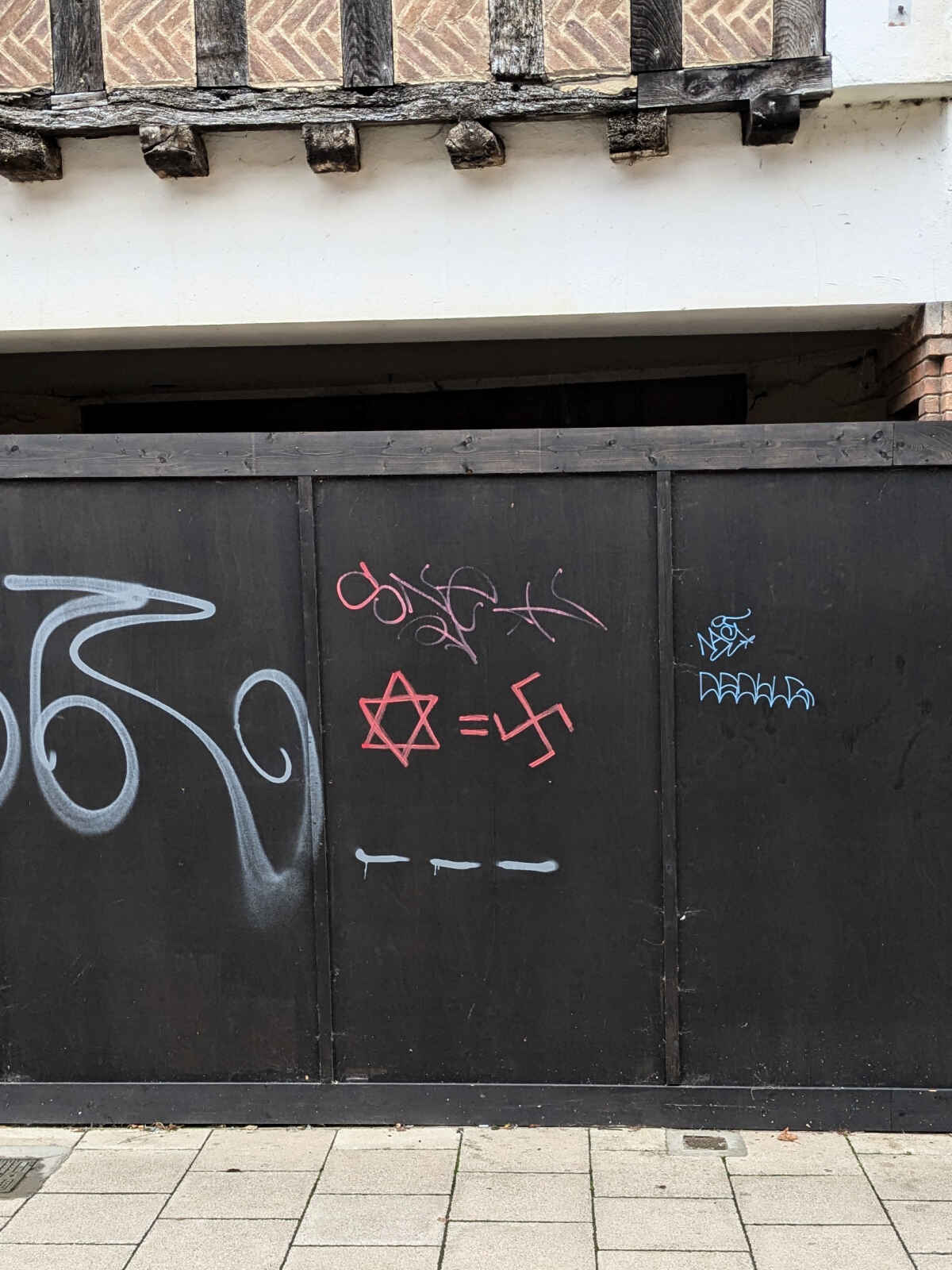
If, however, anti-Israel material (containing no antisemitic language) is sent unsolicited to specifically pro-Israel organisations, then this incident would not be classified as antisemitic. Similarly, if a Jewish individual or group engaging in public pro-Israel advocacy subsequently receives anti-Israel material, comments or questions, this would most likely not be classified as antisemitic (unless, again, it contains antisemitic language). The political discourse used in an incident may also be the reason why the incident is or is not considered antisemitic. In particular, incidents that equate Israel to Nazi Germany would normally be recorded as antisemitic because the comparison is so deeply hurtful and abusive, using Israel’s self-definition as a Jewish state as the basis for the insult. This analogy, made in increasing quantities since 7 October 2023, is reflected in changes to anti-Jewish language, such as in the neologism “Zionazi”. However, incidents that compare Israel to, for example, apartheid South Africa, would not normally be recorded as antisemitic incidents. While the charge that Israel practises apartheid upsets many, it does not contain the same visceral capacity to offend as the comparison with Nazism, which carries particular meaning for Jewish people because of the Holocaust; nor does it play on Israel’s Jewishness as a way of causing hurt.
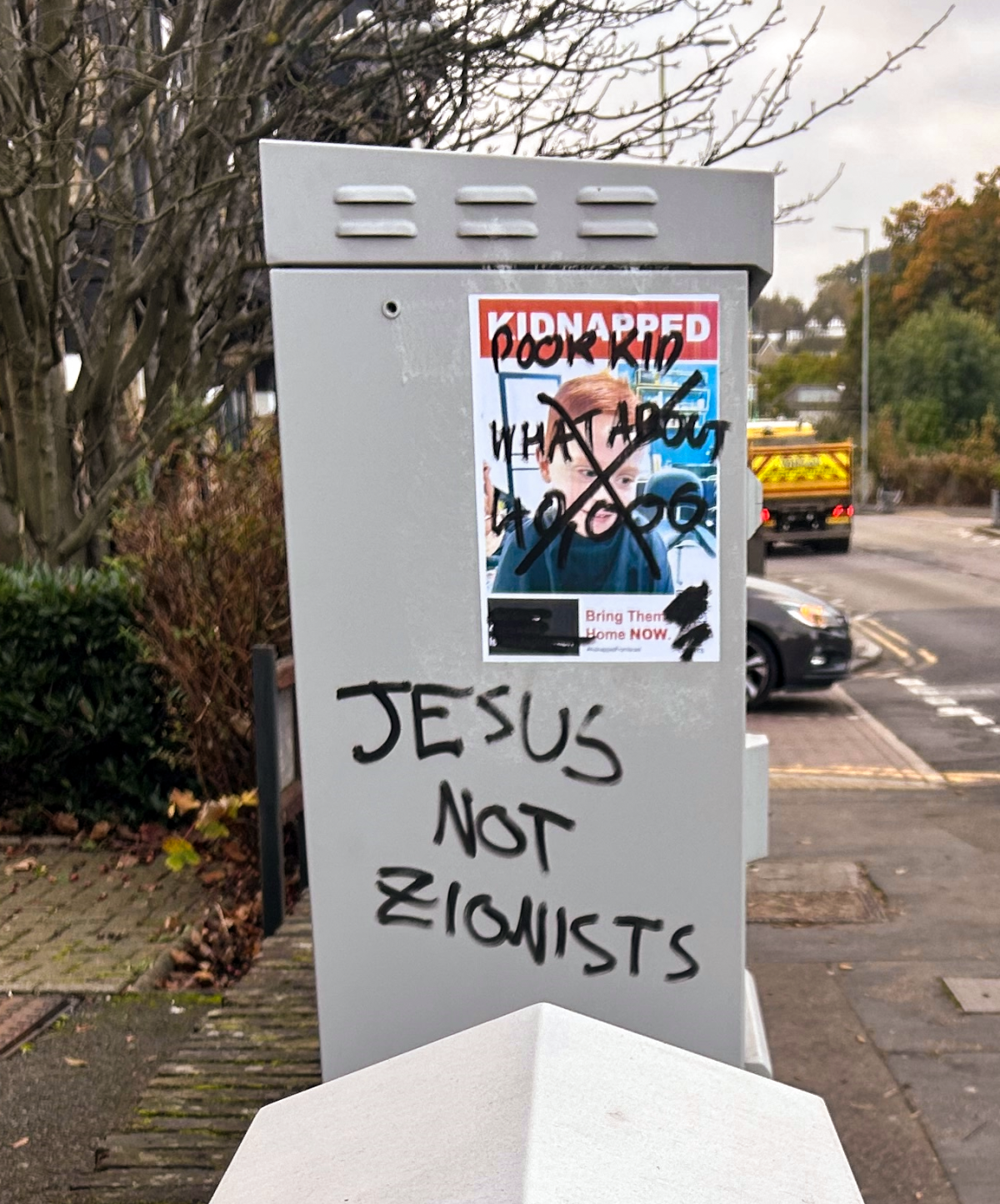
CST recorded 1,844 antisemitic incidents that alluded or were related to Israel and the Middle East in 2024. Of these, 327 included a comparison between Israel and the Nazis, while the terms “Zionism” or “Zionist” were employed in 422 cases of anti-Jewish hate. There were 1,533 reports in which the offender demonstrated outright anti-Zionist motivation that went beyond more superficial discourse about the region or the conflict, alongside explicitly anti-Jewish comments or abuse aimed at unsuspecting Jewish people. Irrespective of whether or not anti-Israel incidents are classified as antisemitic by CST, they are still relevant to CST’s security work as they may involve threats and abuse directed at Jewish people or organisations who work with – or in support of – Israel, and therefore have an impact on the security of the UK Jewish community.
Discourse, motivation & ideology
CST attempts to assess the number of antisemitic incidents that take place in the UK each year within which there is evidence of political, religious, or ideological discourse or motivation. CST also monitors the number of instances where conspiracyfuelled sentiments are present. Stereotypical tropes about the Jewish people’s power, influence, and money – and claims that the tragedies of the Holocaust are exaggerated or invented – can be especially prevalent in online expressions of antisemitism. It is common for two or more of these discourses to exist within the same incident, even if they would seem ideologically incompatible. Such apparent contradictions perfectly capture the multifaceted nature of contemporary antiJewish hate. In total, 2,589 (73%) of the 3,528 antisemitic incidents recorded by CST in 2024 contained one or more political or ideological discourses or motivations. In 2023, they were present in 2,731 (64%) out of 4,296 incidents. This proportional increase in political language and motivations is another indicator of the impact on the language of antisemitism in the UK when Israel is at war.
Historic, simplistic prejudices have been manipulated and deployed by such a vast array of social, religious, cultural and political forces over such a long period of time, that a complex and layered landscape of antisemitic language, imagery and references has emerged. Partly as a consequence of this, the use of a certain rhetoric does not necessarily evidence a specific motivation or allegiance: for example, a person who shouts “Heil Hitler” at a Jewish passer-by might align themselves with far-right extremist ideology, or they might simply know that this phrase will cause upset and offence to Jewish people. Similarly, someone who shouts “Free Palestine” at people walking to synagogue may be a staunch campaigner for Palestinian liberation, or perhaps they just consider it another weapon in their rhetorical arsenal to deploy against Jews.
Israel-related antisemitism

In 2024, the discourse most frequently evident in antisemitic incidents either directly referenced or was linked to Israel, Gaza, the Hamas terror attack on 7 October 2023 or the subsequent Middle East war. This rhetoric appeared in 1,844 (52%) of the 3,528 antisemitic incidents reported in 2024. It is a rise in number and proportion from 2023, when this narrative was evident in 1,832 incidents, 43% of the annual total.

For comparison with a period without a significant trigger event in the Middle East, there were just 246 incidents reported involving this discourse, 15% of the yearly figure, in 2022. On 1,533 occasions, 43% of all reports, antiZionist motivation was exhibited alongside anti-Jewish language or targeting, compared to 1,352 in 2023 (31% of the annual total). Meanwhile, variations on the words “Zionism” or “Zionist” were employed in 422 cases, either as euphemisms for “Jewishness” and “Jew” or alongside other antisemitic language or imagery, rising by 56% from 271 incidents of this kind in 2023.

There were at least 355 instances wherein the phrase “Free Palestine” was used for antisemitic purposes, either as spoken or written text. CST does not consider this sentiment to be inherently antisemitic and would not record use of this phrase in isolation as an antisemitic incident, but in these 355 cases, it was directed in a hostile manner at Jewish people or institutions – who had not solicited discussion about the Middle East – purely because they were perceived to be Jewish, or was part of a wider act that did include explicitly anti-Jewish abuse.
Holocaust-related antisemitism
In 909 incidents – 26% of the 3,528 antisemitic incidents reported to CST in 2024 – the offender or offenders alluded to Hitler, the Nazis, the Holocaust, used rhetoric associated with the period of Nazi rule, and/or punctuated their abuse with a Nazi salute, the depiction of a swastika, or other related imagery. This is a decrease of 9% from 2023, when 1,001 incidents – 23% of the annual figure – employed these references. This is usually the most prevalent discourse in anti-Jewish hate in the UK during periods when antisemitism is not affected by Israel-related trigger events, and remains a significant reference point for antisemites during periods when it is. Sixty-one of these 909 incidents contained the denial of either the scale of the Holocaust or its having happened at all, falling from 70 in 2023. In 138 of these 909 reports, the Holocaust, its perpetrators and/or their ideas were glorified, or the desire for its repeat was expressed, compared to 190 in 2023. On eight occasions, the perpetrator simultaneously denied and glorified the Holocaust, a contradiction that encapsulates how confused and blurred antisemitic ideas can be in the minds of people who hate Jews. In 298 of these 909 incidents involving Nazi-related hate speech, the abuse was graffitied, daubed, scratched, stuck or printed on public or private property, usually including the graphic of a swastika. There were 175 cases wherein the offender’s far-right allegiance or political motivation were identified, 104 of which were accompanied by Nazi-era allusions, increasing from 154 and 103 such incidents respectively in 2023. Meanwhile, there were 327 incidents in which a direct comparison was made between Israel and Nazi Germany, rising from 257 such instances in 2023. Cases in which offenders drew this parallel are counted among both the totals for Israel- and Holocaust-related rhetoric, bridging the two most popular discourses employed by antisemites in 2024.
Religiously motivated antisemitism
CST recorded 156 antisemitic incidents in 2024 that contained discourse relating to Islam and Muslims, and Islamist groups, rising from 129 such incidents in 2023. In 65 cases, Islamist extremist ideology was present, decreasing from 88 in 2023. This may indicate that, while rhetoric mentioning Islam remains more prevalent in anti-Jewish hate while Israel is at war with Hamas, extremist language has subsided as time has elapsed since the Hamas terror attack on 7 October 2023, which incited and elicited immediate vocal support from those who revelled in the awful events of that day. Of these 65 Islamist extremist incidents, 43 were related to war in the Middle East, either demonstrating militant support for Hamas and the 7 October terror attack, or advocating for similar events in the future, usually directed at random Jewish people or organisations because they are Jewish. An additional 54 reports of anti-Jewish hate featured another religious ideology, up from 50 in 2023.
Conspiracy theories
Antisemitic conspiracy theories were evident in 487 (14%) of the 3,528 antisemitic incidents reported in 2024, marking an increase from the 325 such incidents recorded in 2023. Of these, 345 discussed Jewish power over global politics, media, finance and other industries (compared to 268 in 2023); 108 spread falsehoods about religious rituals and practices, such as Blood Libel (up from 40 in 2023); fifteen involved conspiratorial myths regarding the origins of Jews and Jewishness in attempts to undermine the legitimacy of any concept of modern Jewish identity (a rise from nine incidents of this nature reported in 2023).
Antisemitism targeting customs and texts
Specific aspects of Judaism were attacked or deliberately mischaracterised for antisemitic purposes in 100 instances, more than the 58 such incidents recorded in 2023. Forty-five manipulated ideas and stories taken from religious scripture (compared to 21 reported in 2023); 39 focused on religious literature (rising from 18 in 2023 that targeted specific Jewish holy books); and 16 singled out religious traditions (a decrease from 21 in 2023). In 332 cases, the antisemitism was littered with anti-Jewish stereotypes, caricatures, or dehumanising language and imagery, more than the 179 such examples in 2023. There were 11 examples of antisemitic abuse concerning specific ethnic groups that exist within the wider Jewish world, one more than the ten such cases reported in 2023.
Politically motivated antisemitism
Antisemitic incidents are classified as connected to specific political parties based on the offender’s stated affiliation or support; because the abuse was targeted at, or expressed by, party members, activists or representatives; or because an incident appeared to be motivated by news stories related to that party. It is often not possible to ascertain whether the offenders are themselves party members or not; in some cases, they have been expelled from their former party but continue to express antisemitism in relation to it. These caveats mean that these totals are not indicators of the relative amounts of antisemitism within, or tolerated by, each political party. In 2024, CST recorded 70 antisemitic incidents that were politically motivated or linked to specific political parties or their supporters, an increase of 46% from 48 reported in 2023. Two of these were connected to the Conservative Party (equal to 2023’s total), one to the Liberal Democrats and one to the Green Party; seven to the Socialist Workers Party, one to the National Housing Party UK, and seven to independent parliamentary candidates and councillors (all of which had no related incidents in 2023). Meanwhile, there were 50 antisemitic incidents linked to the Labour Party, a small rise from 45 in 2023. Thirty-nine of these 50 Labour Partyrelated incidents also made reference to the Middle East: in 19 of them, Keir Starmer and/ or his party were criticised using antisemitic language for their stance on Israel, or were implied to be under Israel or “Zionist” control, while seven suggested that Jeremy Corbyn’s expulsion from the party was the consequence of a Jewish plot to damage his reputation with falsified claims of antisemitism. The fact that so many of the Labour Party-related incidents involved antisemitic attacks on the current party leadership illustrates the risk in assuming that these totals indicate relative levels of antisemitism within, or tolerated by, each party. Nine of the 70 politically motivated incidents reported to CST in 2024 occurred in the period between the announcement of the general election on 22 May and the confirmation of the election results on 4 July.
The fact that over half of the anti-Jewish hate reports to CST in 2024 contained Israel-related discourse is significant, albeit unsurprising. Throughout history – and found in CST’s analyses since it began recording antisemitic incidents in 1984 – the language of antisemitism has changed in accordance with the specific contemporaneous sociopolitical context. Circumstances in the Middle East, and the prolonged period of warfare in the region, provide a useful focal point for current expressions of anti-Jewish hate: while it is not true that all who hate Israel hate Jews, there is statistical evidence that the stronger a person’s anti-Israel views are, the more likely they are to hold antisemitic attitudes as well. A further truth is revealed upon examination of the meta-narratives that coalesce within the current prevalence of Israel-adjacent antisemitic discourse: although the language of antisemitism may change, the ideas that underpin it do not. For example, of the 108 incidents wherein the offender indulged in myths about Jewish religious rituals, 94 invoked the centuries-old conspiracy theory of the Blood Libel alongside anti-Israel rhetoric. In this modern reworking, the tragic death of innocent children in Gaza is framed as the logical consequence of the supposed Jewish lust for infant mutilation and blood. It is impossible to know if every purveyor of this notion is familiar with the origins and history of associations of this canard, but the core tenets of classical anti-Jewish hate have been recycled so often as to be deeply embedded into public and individual consciousness, providing a blueprint for the antisemites of today.
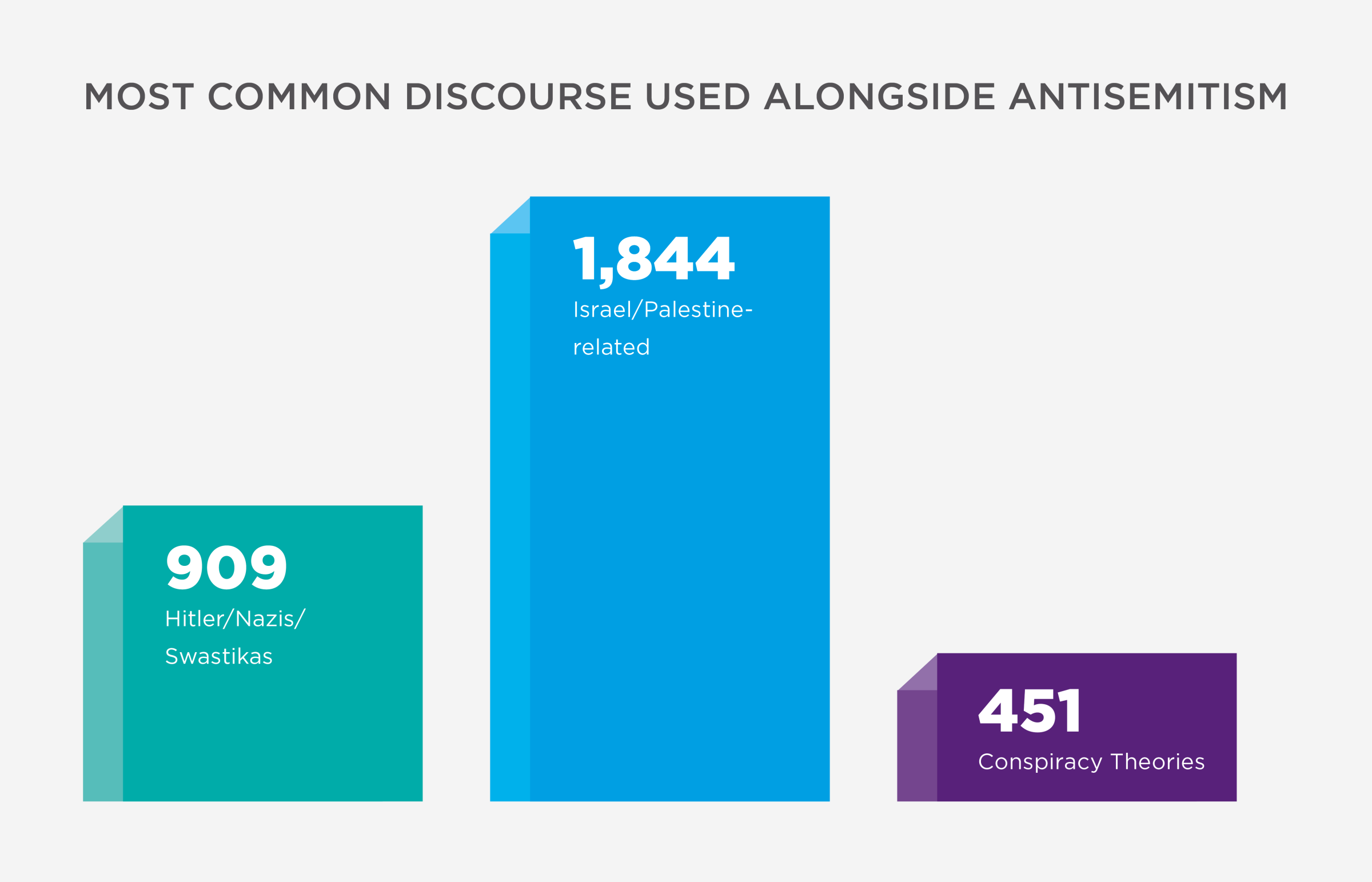
Two hundred and seventy-one of the 345 incidents involving accusations of disproportionate Jewish power sat alongside rhetoric pertaining to the Middle East. In these cases, Israel and/or “Zionists” were charged with having their hand in all manner of global activities, including the control of foreign governments, the running of various industries, the manipulation of economic and migration systems, and clandestine involvement in different atrocities, from 7 October to 9/11. The long-standing trope of Jewish people belonging to a uniquely evil, self-serving and omnipotent cabal is the source of these narratives, which are once again chameleonic against the backdrop of war in the Middle East, updated to fuel and legitimise hatred for Israel, Zionism and the Jews who identify with them.
As well as a reverence for classical antisemitism, a defining feature of contemporary anti-Jewish hate is the abuse of historic Jewish trauma. This is demonstrated in the 327 incidents involving comparisons between Israel and Nazi Germany, and between the war in Gaza and the Holocaust. This analogy purposely inverts and weaponises Holocaust memory and the significance it holds for Jewish people. In these cases, the Holocaust is reduced to a mere rhetorical device, used to taunt Jews over their perceived culpability for the civilian casualties in Gaza, or painting them as inheritors of the evil of Nazism. Ultimately, these equivalences only serve to diminish the singularity and severity of both events.
The twisted hypocrisy at the core of this parallel – and much of modern-day antisemitism – is also apparent in the 46 incidents that contained Holocaust glorification while referencing Israel and the Middle East. Perpetrators of these incidents celebrated Hamas’ attack on 7 October 2023 as a long-awaited, aspirational sequel to the Nazi mass-extermination of Jews, or they lamented Hitler’s failure to fully wipe out Europe’s Jewry for, if he had succeeded, there would be no Israel and no war in Gaza. Feelings of hostility towards Israel, Zionism and Jewish people who believe in the legitimacy of these two concepts are usually presumed to be the preserve of far-left thought. The collision of these narratives show that ideologies usually associated with Nazis, fascists and the far right have been folded into the mainstream antisemitic discourse which, in 2024, was predominantly centred around events in the Middle East. This is the melting pot of Jew-hatred, where people and ideas of seemingly incongruous social, political and cultural standpoints can find common ground in a shared prejudice, and bridge otherwise extreme incompatibilities.
The examples discussed within this chapter showcase the complexity and opportunism of contemporary anti-Jewish hate, and the difficulty in confronting it. This hatred is packed with a library of falsehoods, stereotypes, conspiracies and fantasies from which its perpetrators can draw and give new life, moulded to fit their personal value system and the world around them. Of the 2,589 antisemitic incidents reported to CST in 2024 that featured at least one of the discourses explored in this chapter, 344 (13%) combined at least two of them.
Geographical locations
Of the 3,528 antisemitic incidents recorded by CST in 2024, 2,327 occurred in Greater London and Greater Manchester, the two UK cities where the largest Jewish populations reside.
In the former, 1,847 incidents were reported, marking a fall of 24% from the 2,441 incidents recorded in 2023, the only year in which more London-based anti-Jewish hate was logged. This is also the case for Greater Manchester, where 480 antisemitic incidents were logged in 2024, a 13% drop from 2023’s total of 556 incidents in the region.
CST recorded at least two antisemitic incidents in each of London’s 33 boroughs. Of the 1,847 incidents reported across Greater London in 2024, 791 occurred in Barnet, the local authority that is home to the biggest Jewish community in the country. There were 213 instances of antisemitism reported to have taken place in Westminster, 170 in Camden, 96 in Hackney and 56 in Brent. Each of these boroughs are areas where Jewish people live, work, pray and go to school, but Westminster ranks higher than in the years preceding 7 October 2023. Its figure is partly boosted by the number of antisemitic incidents reported at anti-Israel marches and vigils for Hamas’ victims that took place in the centre of the capital. While most people attend these demonstrations peacefully and without spouting hate, at least 28 incidents of antisemitic speech or placards were recorded at or in transit to or from these events.
Within Greater London’s statistics are 119 incidents that took place on the London transport network, of which 68 happened on property that falls under the remit of British Transport Police. A further 87 were online incidents where either the victim or offender is understood to be based in London, but a more specific location could not be established. The tally for Greater London would be even higher, were it not for disruption to the flow of antisemitic incident data from the Metropolitan Police since March 2024 due to a technical problem. CST’s daily work with the police is of huge value and remains a fundamental element of CST’s mission.
Of Greater Manchester’s 480 antisemitic incidents, 161 occurred in the City of Manchester, 129 in Bury, 115 in Salford, 26 in Trafford and 16 in Stockport. Within this data set, nine cases of anti-Jewish hate took place on Greater Manchester’s transport network, and seven were online incidents where either the victim or offender is known to be based in Manchester, but a more specific location could not be established.
Taken together, the antisemitic incidents recorded across Greater London and Greater Manchester comprise 66% of the annual total: a significant proportion, if less than the 70% in 2023. Antisemitism remains most prevalent in the areas where Jewish community is most deeply rooted and visible. Contemporary antisemitism, however, still finds expression throughout the country. The only police constabularies within mainland Great Britainand Northern Ireland where CST did not record a single case of anti-Jewish hate in 2024 were Lincolnshire and Suffolk. This broad geographical spread reflects both the diversity of the UK’s Jewish community – there are Jewish people living in every local authority in the UK, if not visible Jewish communities as such – and the impact of social media.
Online platforms have reduced the necessity of proximity to Jewish people and communities in order for antisemitism to reach its target.
In the context of this evolving landscape, CST has grown its virtual footprint, in turn broadening the public’s capacity to report antisemitism, whether it occurs online or not. Furthermore, the partnership and data-sharing agreements with police services around the country have been vital in widening CST’s knowledge of where and how anti-Jewish hate manifests across the UK. Of the 3,528 antisemitic incidents recorded by CST, 636 (18%) were reported to CST by the police.
Aside from Greater London and Greater Manchester, the police regions with the highest antisemitic incident totals reported in 2024 were West Yorkshire with 184 incidents (compared to 165 in 2023); Hertfordshire with 117 (an increase from 113 in 2023); Scotland with 74 (up from 68 in 2023); Thames Valley with 65 (a rise from 43 in 2023); and West Midlands with 63 (equal to 2023’s total).
Apart from Greater London and Greater Manchester’s boroughs, the cities and towns where antisemitism was most often reportedwere Leeds in West Yorkshire (129 incidents); Borehamwood & Elstree in Hertfordshire (49 incidents); Birmingham in West Midlands (47 incidents); Brighton & Hove in Sussex (43 incidents); and Liverpool in Merseyside (38 incidents).
Included within all the figures in this chapter are the 140 instances of anti-Jewish hate that took place on public transport or at transport stations: 45 on London buses, 59 on the London Underground, and 36 on other transport services. An additional 11 incidents were recorded where private minicab drivers subjected Jewish passengers to abuse or refused their fare because they were Jewish. Twenty-seven of these 151 combined incidents were classed as Assault, five as Threats, and 119 as Abusive Behaviour. Children were targeted in at least 49 (43%) of the 114 incidents that occurred either on public transport or in private taxis (where CST obtained information about the victim or victims’ age). This is a high percentage when compared to the presence of child victims in just 21% of the cases of anti-Jewish hate for which this information was available that did not occur in these environments. In 25 of these 49 incidents, the children were on their way to or from school.
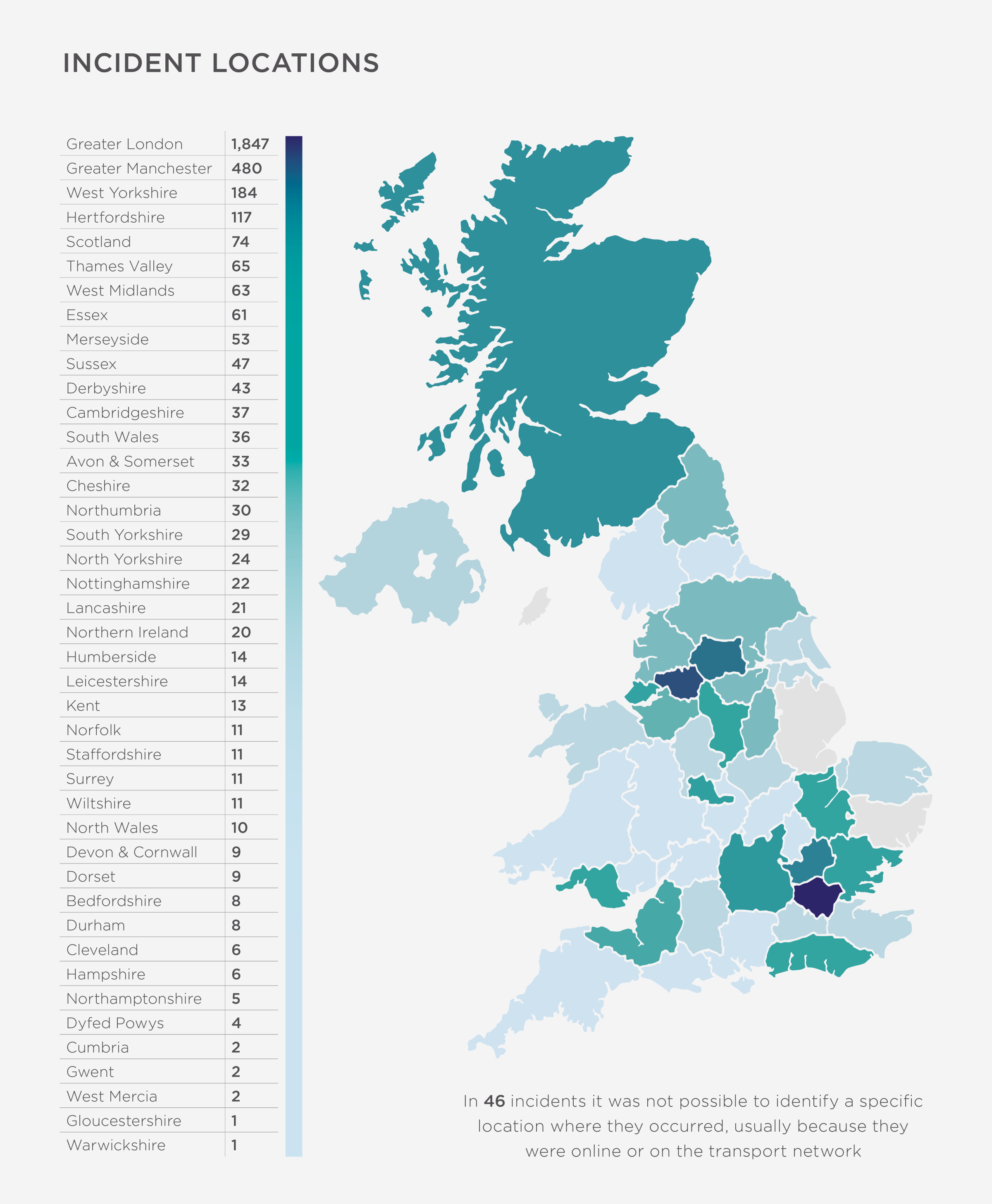
Incident reporters
Not every incident recorded by CST has an identifiable victim. Not every incident recorded by CST has an identifiable perpetrator; but every incident recorded by CST has a reporter. Antisemitic incidents are reported to CST in a number of ways, most commonly by telephone, email, the CST website, via CST’s social media profiles, or in person to CST staff and volunteers. Incidents can be reported to CST by the victim, a witness, or an individual or organisation acting on their behalf. In 2001, CST was accorded third party reporting status by the police. CST has a national Information Sharing Agreement with the National Police Chiefs’ Council (NPCC), and similar agreements with a number of regional forces, which allow CST to share antisemitic incident reports, fully anonymised to comply with data protection requirements, so that both CST and the police can glean as complete a picture as possible of the number and nature of reported antisemitic incidents. CST began sharing antisemitic incident data with Greater Manchester Police in 2011, followed by the Metropolitan Police Service in 2012. Now, using the national agreement, CST shares anonymised antisemitic incident data with several forces around the UK. Any duplicate incidents that are reported to both CST and the police are excluded from this process to ensure there is no ‘double counting’ of incidents.
This collaboration continues to prove incredibly fruitful. In 2024, 636 of the 3,528 antisemitic incidents recorded by CST were reported by the police: 18% of the total. It is a decrease in number and proportion from 2023, when 1,335 incidents were reported by the police, 31% of the annual figure. This decrease is mainly a result of IT issues causing disruption to the flow of reports sent by the Metropolitan Police from March onwards. The Metropolitan Police Service remains a vital partner for CST, providing 140 of the 636 incidents recorded through the Data Sharing Agreement. Meanwhile, 201 came from Greater Manchester Police, 72 from West Yorkshire Police, 33 from Essex Police, 27 apiece from Cheshire Police and Derbyshire Police, and 136 from other police services around the country. Some of these partnerships have existed for a long time, others have been established more recently, and it is thanks to the work invested in building and maintaining these relationships that the police are able to contribute so greatly to CST’s appreciation of the landscape of antiJewish hate in the UK.
In 2024, 1,166 of the 3,528 antisemitic incidents recorded by CST were reported by the victim, while 713 were reported by a witness to antisemitism, whether exhibited online or in a public space. In 290 instances, a friend, relative or support provider related details of the incident, accounting for 8% of all incidents reported to CST. This is in keeping with percentages observed over the past four years, when children have been targeted in increasing proportions, and parents, teachers and caregivers have reported on their behalf. In total, victims, witnesses and those close to the victim reported 61% of the anti-Jewish hate incidents recorded by CST in 2024, building on 56% in 2023 and 44% in 2022. While this proportionate increase is partly a consequence of the reduction in incident data from the Metropolitan Police, it perhaps also indicates a community with greater incentive to report antisemitism since 7 October 2023, given the anxiety and uncertainty that has pervaded in the context of rising levels of anti-Jewish hate.
CST staff reported 512 occurrences of antisemitism, which includes online abuse directed at or tagging CST social media accounts and sent to CST email addresses. One hundred and four antisemitic incidents were reported by security guards at Jewish premises, while 55 came to CST’s attention through the CST volunteer network. A further 39 incidents were uniquely forwarded by the Community Alliance To Combat Hate (CATCH), a partnership of community organisations in London to whom those who report hate crime to the police can be referred if they desire specialist support. Five reports were made by Manchester Shomrim, five by other hate crime partners, and three were taken from reports in the media.
Every single report helps CST better understand the nature and scale of antisemitism in the UK. Every single report better enables CST to protect, support and facilitate Jewish life.
Information collection & suspicious behaviour
One of the most important jobs CST does is to record and analyse incidents of potential hostile reconnaissance, categorised by CST as Information Collection and Suspicious Behaviour around Jewish locations. Although these potential incidents are not included in CST’s antisemitic incident statistics, they still form a vital part of CST’s work as they relate directly to the security of the Jewish community.
The recent tragic history of antisemitic terrorism perpetrated in Israel by Hamas, as well as against global Jewish communities and at Jewish schools, synagogues, shops, museums and other buildings in Colleyville, Pittsburgh, Halle, San Diego, Copenhagen, Paris, Brussels, Toulouse, Kansas City, Mumbai and elsewhere attests to the importance of this work. Jewish communities have long been the targets of terrorists of different and varied political and religious motivations. Since the late 1960s, there have been hundreds of terrorist attacks, attempted attacks and foiled terrorist plots against Diaspora Jewish communities and Israeli targets outside Israel. In the UK, several terrorist plots involving the aspiration to attack the Jewish community came to trial or were publicised via the media in recent years. It is well known that terrorist actors often collect information about their targets before launching an attack: identifying and preventing the gathering of this kind of information is an integral part of CST’s work in protecting the UK Jewish community from terrorism. To be effective in keeping the public safe, CST relies on information from the public as well as CST’s own volunteers and from commercial guards, and CST encourages the Jewish community to report any suspicious activity to CST, as well as to the police.
CST works closely with the police to gather, record and investigate incidents of information collection and suspicious behaviour. CST does this to keep the Jewish community safe and allow it to carry on as normal. Cases of potential Information Collection and Suspicious Behaviour are not included in CST’s antisemitic incident statistics, as the motivation for many of them cannot be determined and many may have innocent explanations. The vague and uncertain nature of many of these incidents means that they are easier to analyse if the two categories are combined, rather than treated separately. Together, there were 640 such incidents reported to CST in 2024, compared to the 672 incidents of this type recorded in 2023, which involved the filming or photography of Jewish buildings, loitering suspiciously around them, and/or the attempted entry to Jewish premises. As a contrast, there were just 235 instances of Information Collection and Suspicious Behaviour reported in 2022. It is likely that this sustained increase is a result of the overall rise in antisemitism since 7 October 2023, the general unwanted attention given to the Jewish community, and the consequent increase in Jewish sensitivity and anxiety ever since. These factors have intensified feelings of fear and insecurity among the community, and a heightened sense of alert has led to more reports of perceived hostile activity. Although most of these reports are likely to have innocent explanations, neither CST nor the police underestimate the threat posed to Jewish communities by various terrorist organisations and networks. Identifying and preventing the potential hostile reconnaissance of Jewish buildings or other potential terrorist targets is an important part of reducing the possibility of future terrorist attacks and is integral to the work of CST.
Annual antisemitic incident figures
Some of the numbers in the tables may differ from those previously published by CST, due to the late reporting of incidents to CST by incident victims and witnesses, or the recategorisation of some incidents due to new information.
Antisemitic incident f igures by category, 2013–2024
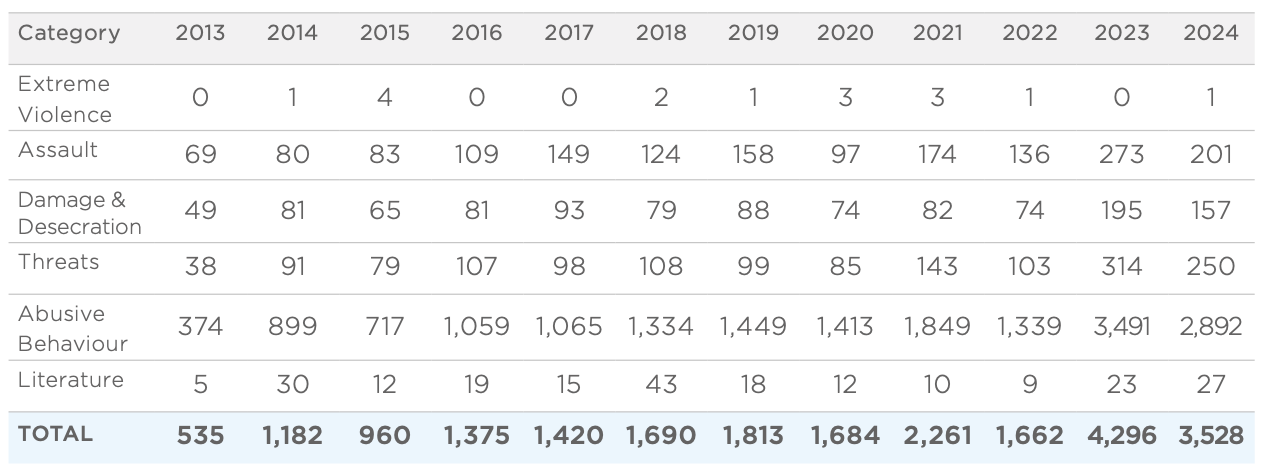
Antisemitic incident f igures by month, 2013–2024
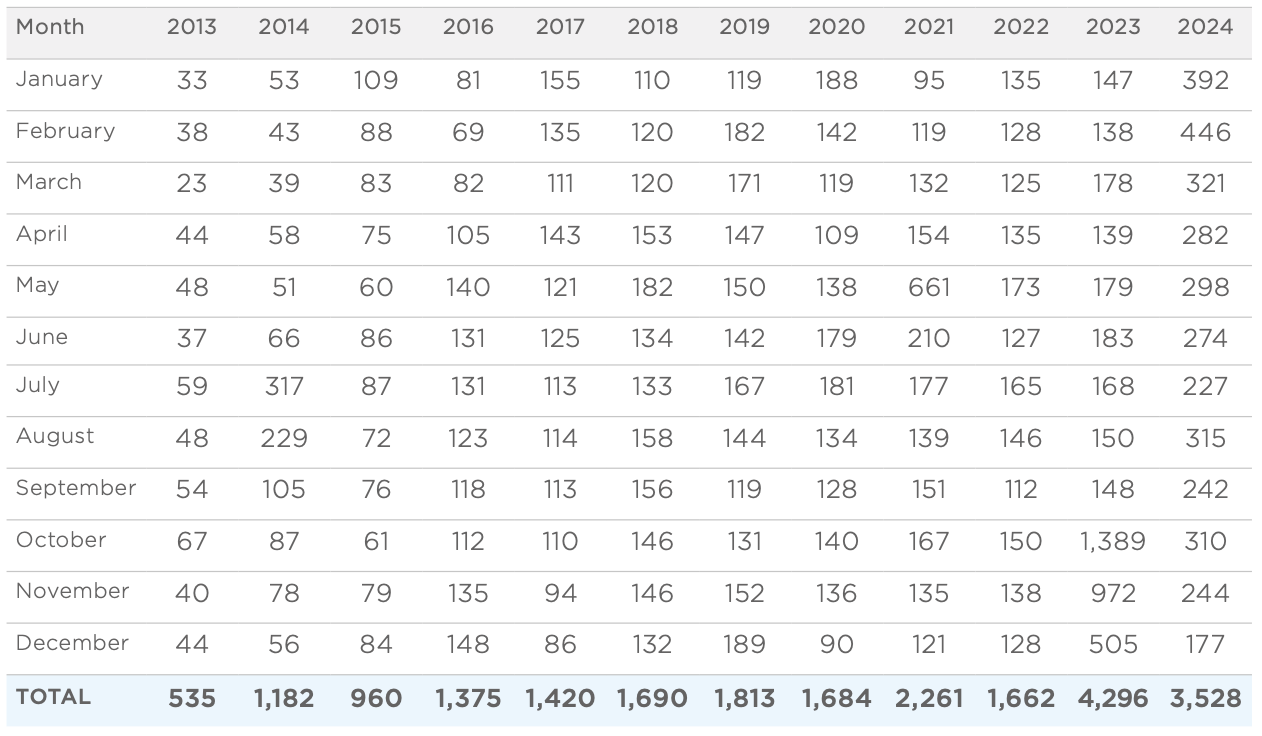
Antisemitic incident f igures, full breakdown, 2024
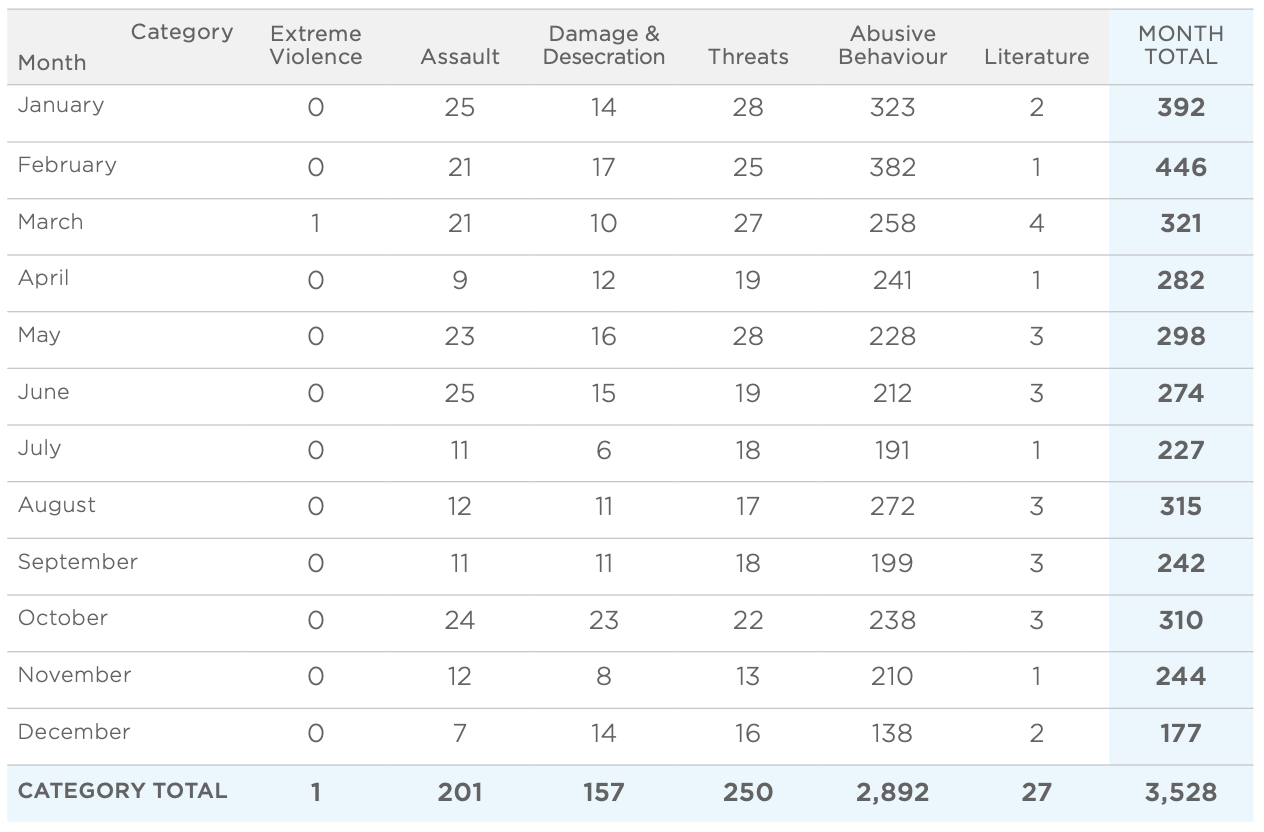
Footnotes
- The incident totals for past years and months in this report may differ from those previously published by CST, due to the late reporting of some incidents to CST by incident victims, witnesses or other sources. Figures published in this report are also subject to change for the same reason.
- Antisemitic Incidents Report 2023
- These include antisemitic incidents reported to CST occurring within that specific party, directed towards politicians and members of that party, expressed by that party’s politicians and members (or both), or antisemitic incidents where online offenders displayed clear signs of affiliation to/support of that party in their abuse or their social media profiles. Finally, an incident is also considered party-related for these purposes if antisemitic views appear to be motivated by arguments over alleged antisemitism within it: for example, if antisemitic abuse is directed at a former politician after they have left the party.
- It should be noted that these are incidents related to events in, or arguments about, the Labour Party, and should not be treated as a measure of incidents perpetrated by Labour Party members (which CST is not in a position to assess).
- Scotland is treated as a single geographical area due to Police Scotland being a single police service, but any comparisons of the incident total for Scotland with other much smaller geographical regions should be done with caution.
- These include antisemitic abuse that took place inside and outside stadia; stickers and graffiti related to football clubs and supporter groups; online comments regarding football; and anti-Jewish replies to football clubs posting about Jewish holidays on social media.
- Hate crime | The Crown Prosecution Service
- Antisemitic expressions that fall outside this definition of an antisemitic incident can be found in CST’s Antisemitic Discourse Report
- Information Sharing Agreement
- Hate crime, England and Wales, year ending March 2024 - GOV.UK
- These include attacks where mixed groups of adults and minors were targeted, as do all the figures in this paragraph.
- This qualifies as Jewish property as it was Jewish people who printed and put them up, and the majority of the posters’ and memorials’ subjects are Jewish too.
- This figure includes bomb threats sent to multiple Jewish locations around the country simultaneously, which CST counts as a single incident.
- For more information on the GDL, see CST’s report Pathway to Terror
